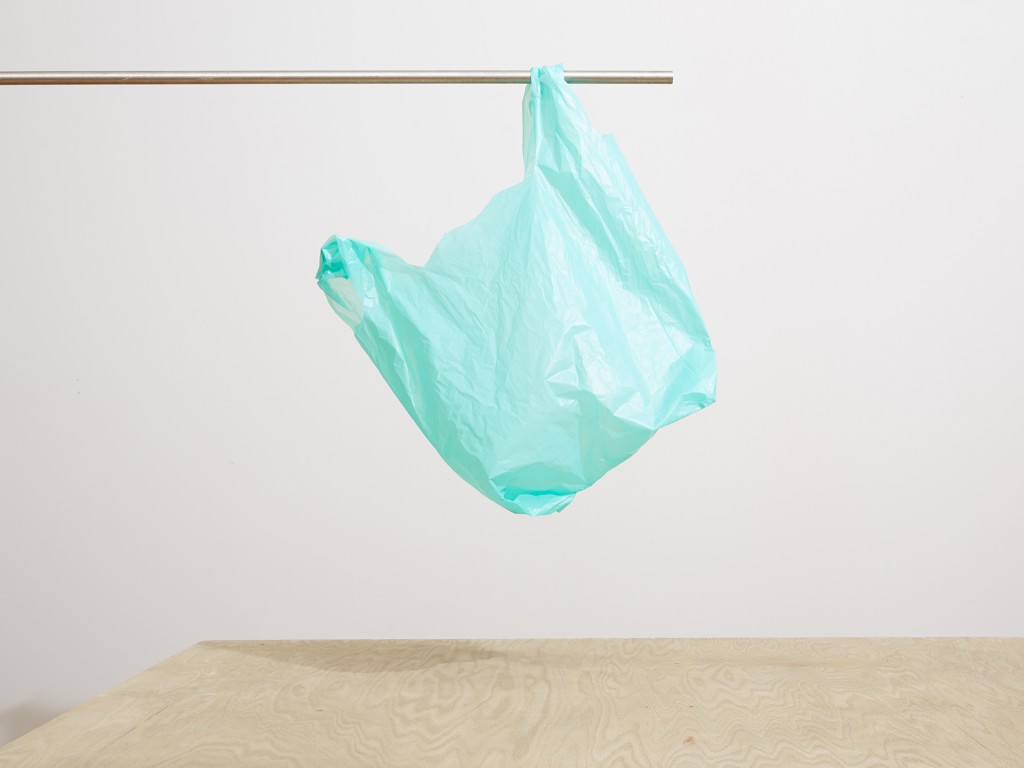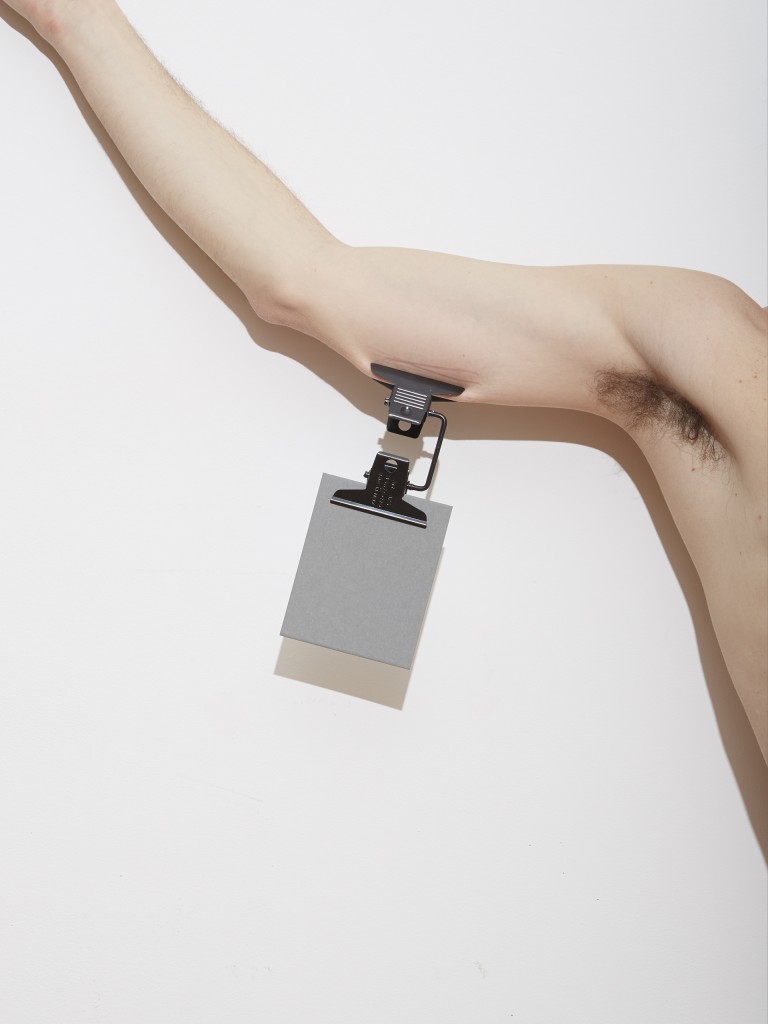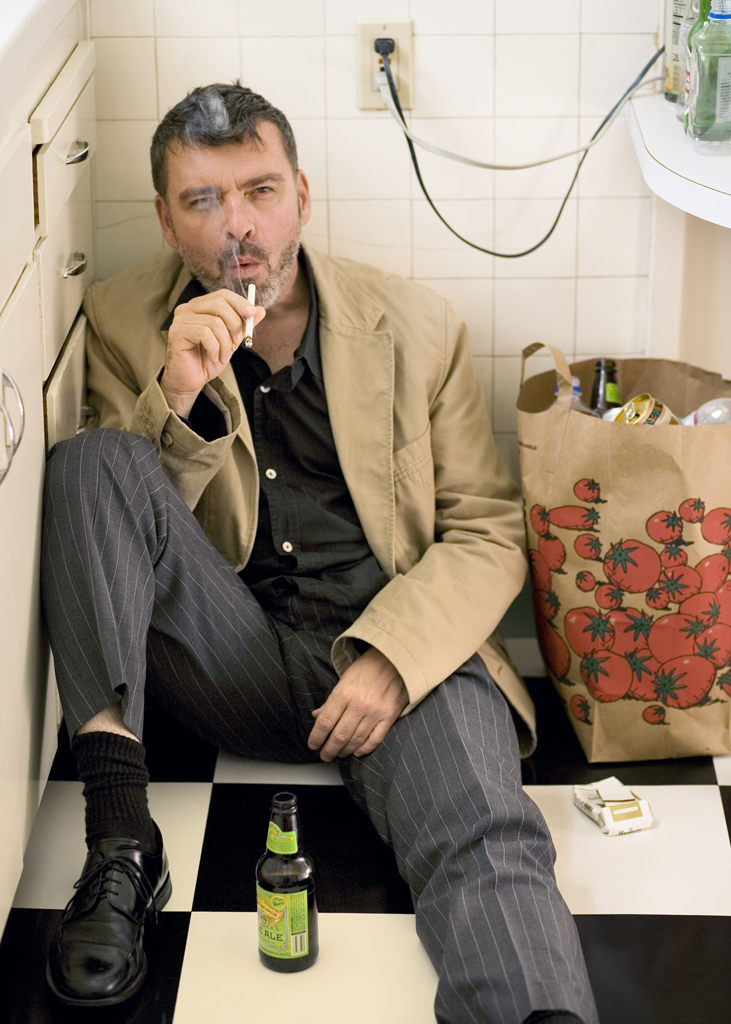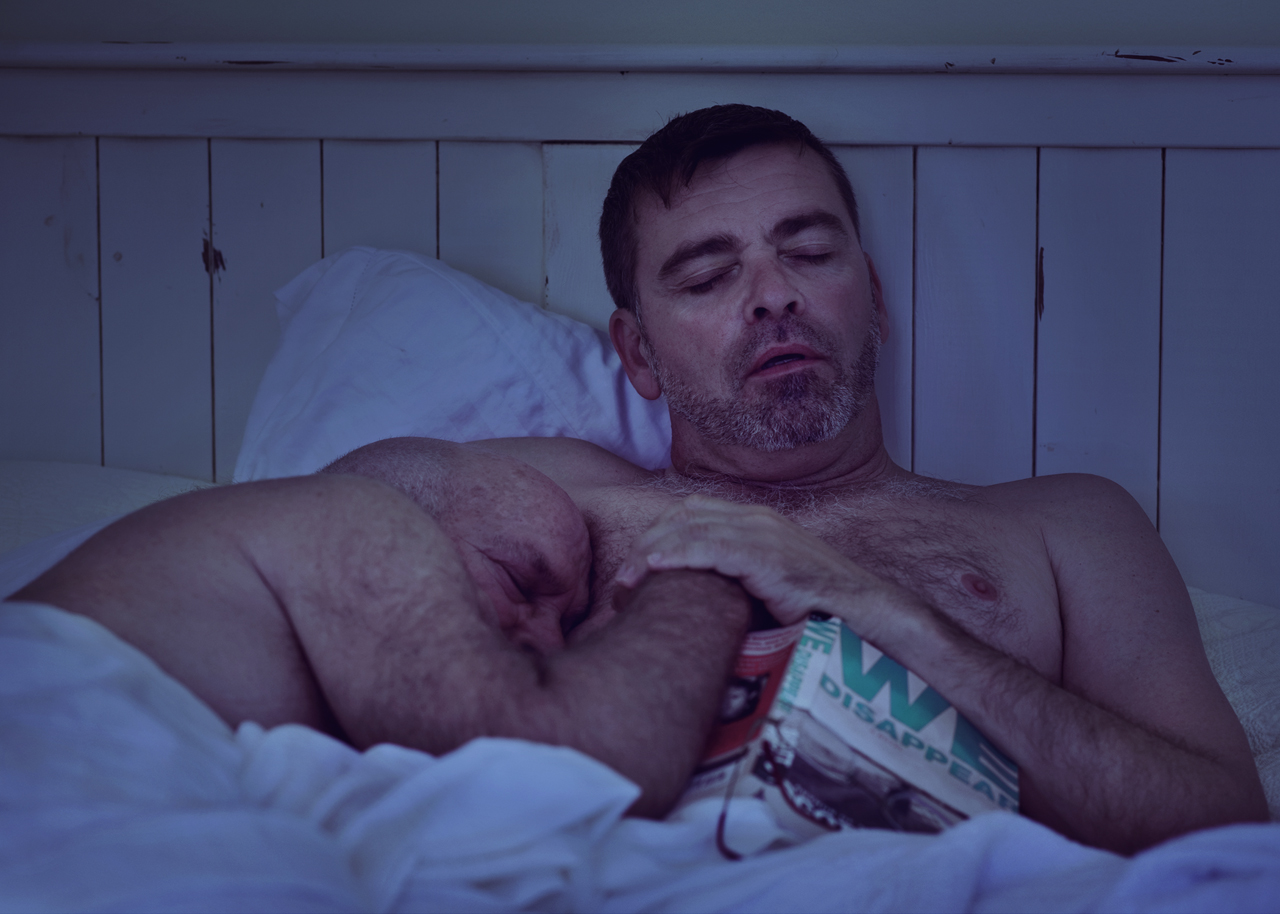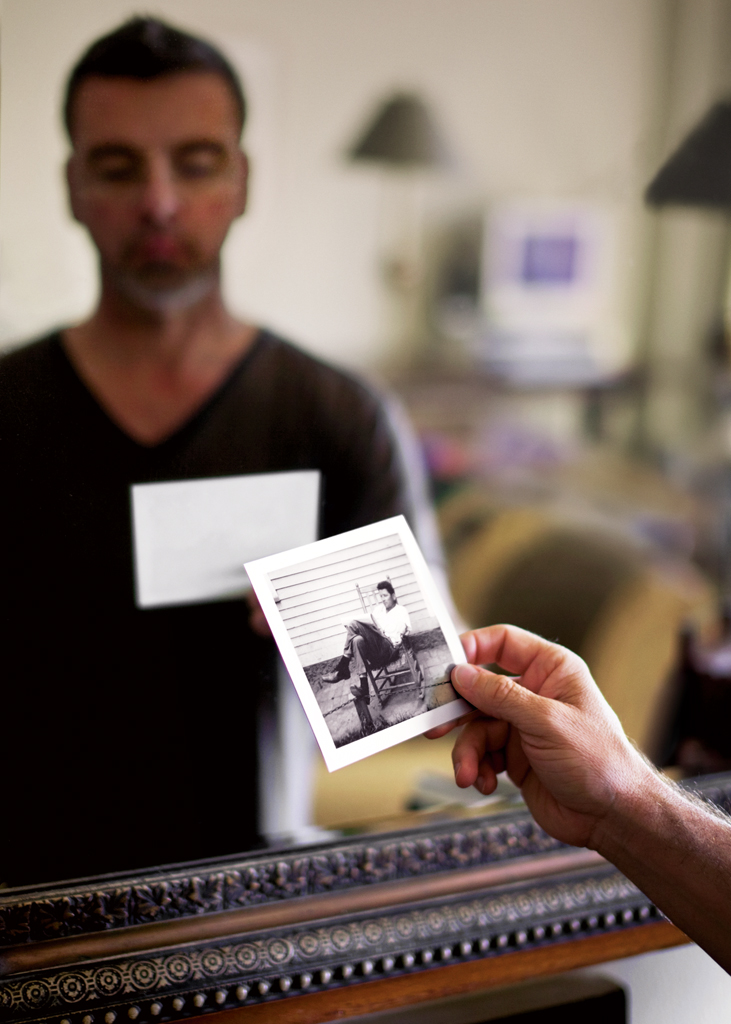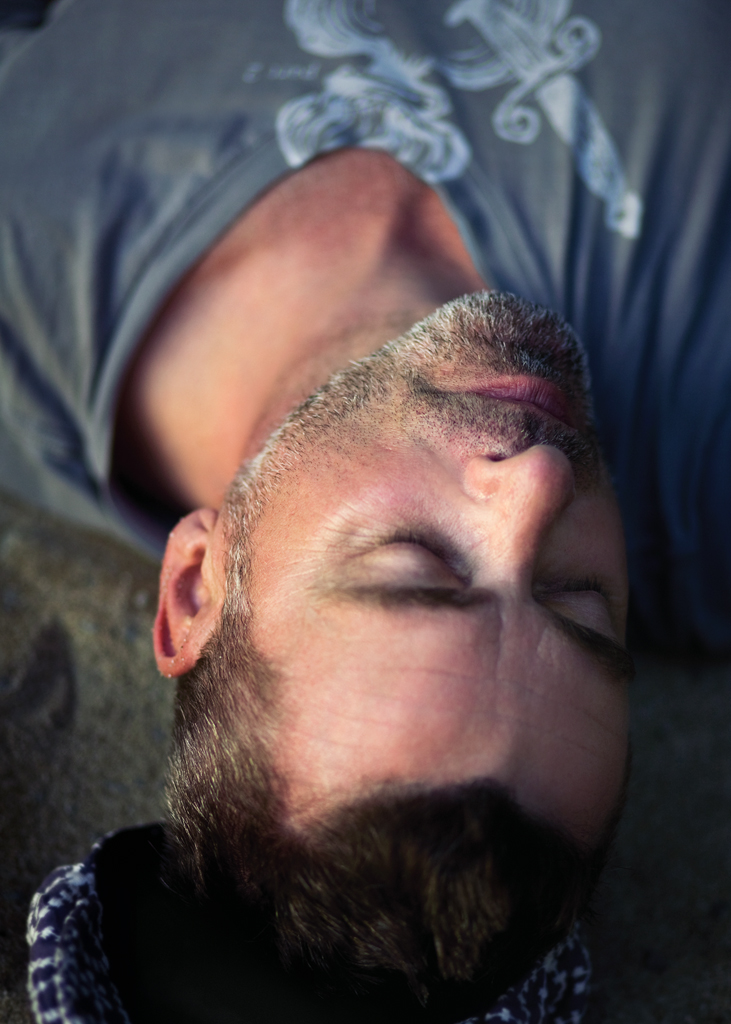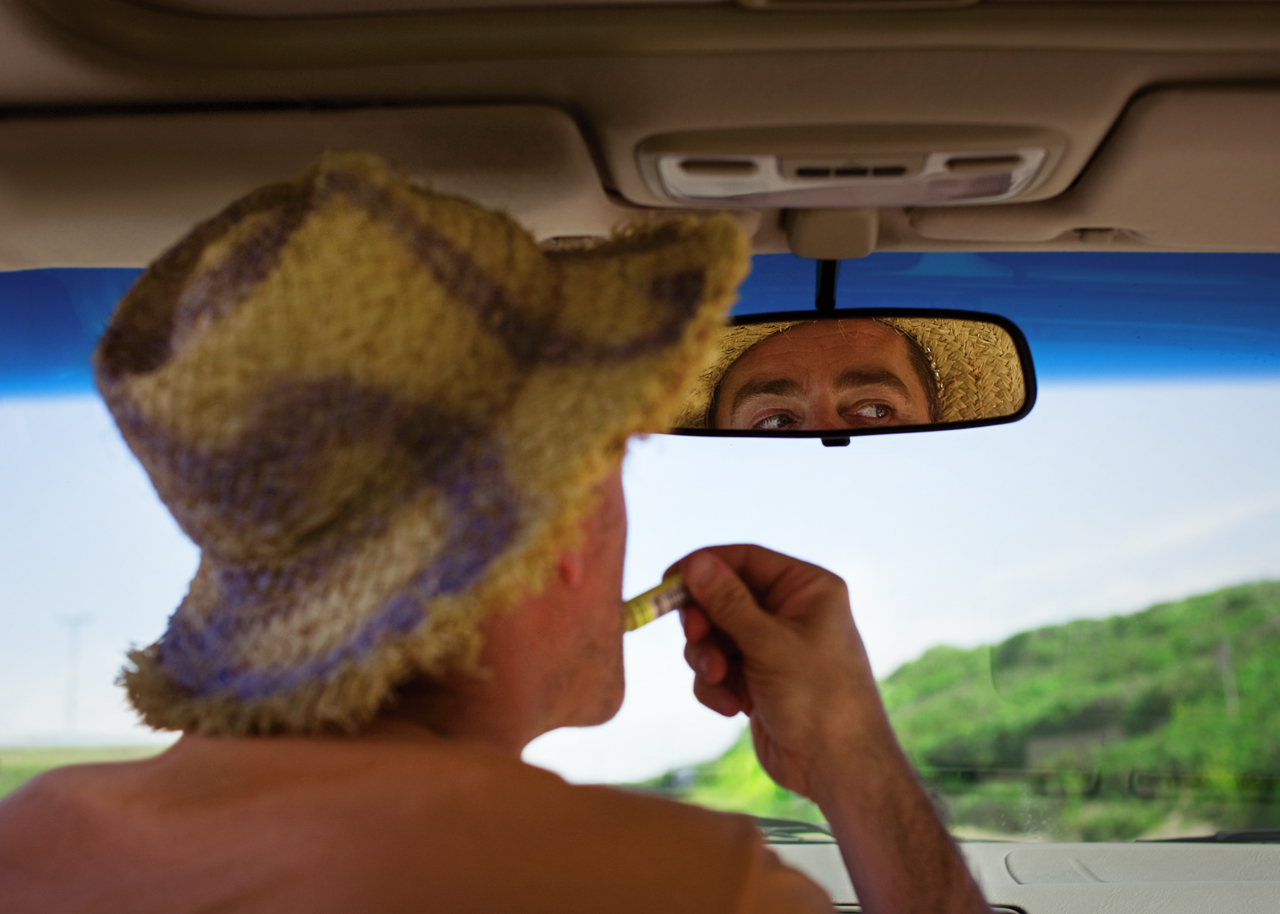at Length
Posts Tagged ‘Photography’
Robert Calafiore
Thursday, June 28th, 2018
Robert Calafiore, interviewed by Debra Klomp Ching, about his extraordinary and colorful pinhole photographs.

Still Life (2017-2018), 10″x8″ unique pinhole C-Type ©Robert Calafiore/courtesy ClampArt, New York
At Length: Your work was initially brought to my attention via your Instagram feed. How important is your social media presence to your creative practice?
Robert Calafiore: A very close artist friend of mine sat me down one day and said she wasn’t leaving my house until I did two things: build a website and open an Instagram account. I did both. I was excited about launching a website and worked for a few weeks to get the first version up and running. However, I was far more hesitant and nearly unwilling to begin a relationship with another social media app. I had read a great deal about the opportunities it might provide for broad exposure of my work but still had lots of questions. My friend advocated for the app and I ventured a toe in, slowly at first, and then more and more calculated as I became more savvy. What we all know now is that it can be a powerful tool. It became clear to me, after I noticed your gallery following my work, that I had to pay attention and learn how to leverage its use. That decision was one of a few pivotal moments that changed the direction of my work as an artist. Some attention had been building, but it was the first exhibition at Klompching in 2015 that made all the difference. It wouldn’t have happened the same way without Instagram.
AL: How and when did you first come to work with pinhole photography?
RC: I have been using an assignment to build a pinhole camera in my experimental photography courses for two decades. Over time, I began to notice a change in the dexterity of my students. What was once a simple project became a grueling task. The cameras were no longer light tight, there were no straight lines and the lids didn’t fit. Students were having difficulty with measuring, cutting and assembling the parts. It intrigued me and my observations of the change grew more careful and led me to study other aspects of their manual skills. I realized that their relationship to their physical world was much different than mine. The sensitivity I had to materials, objects, space and more, was missing or different in my students. I needed to spend time reviewing measurements, using a straight edge to draw and cut lines, holding a utility knife, and using tape while manipulating parts for bonding. Of course, there is now much written about our screen life. It is this shift to an experience of the world through digital life that has altered my students’ manual skills… dexterity. I was fascinated and set down a road to use the pinhole camera myself in a new project I would create around it.
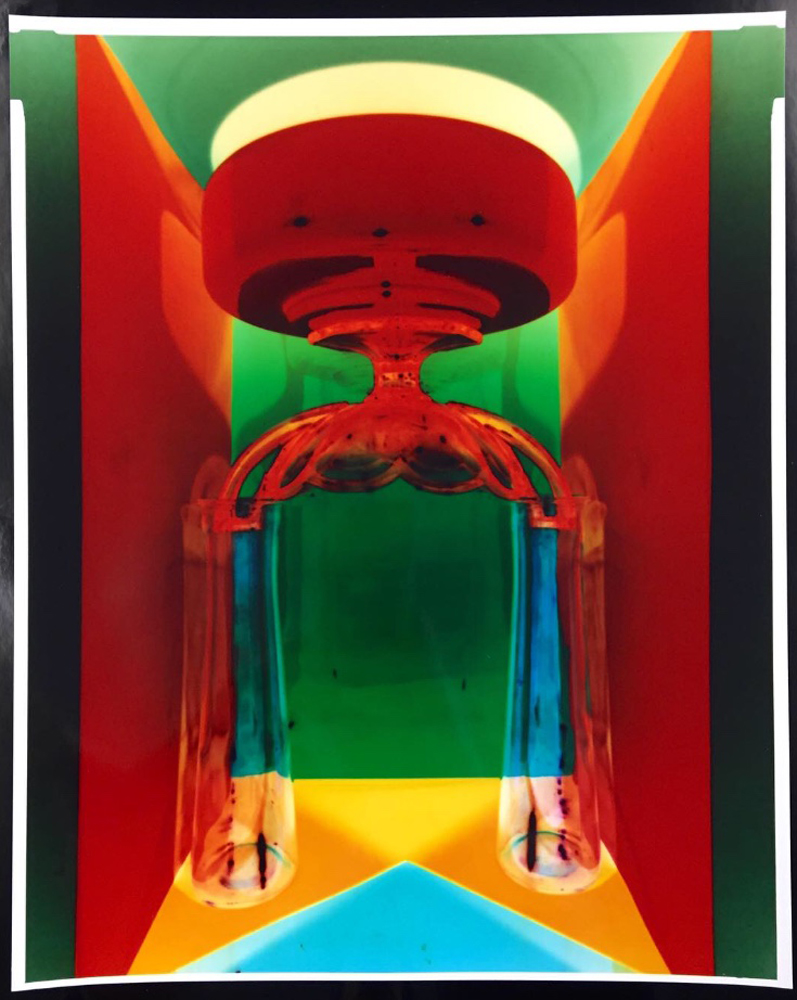
Still Life (2017-2018), 10″x8″ unique pinhole C-Type ©Robert Calafiore/courtesy ClampArt, New York
AL: What was it that inspired you to work with this process? Was it particular photographers, images you had seen, or was it more to do with the process itself?
RC: It was a combination of things. The observations I was making around my students and a passion that was growing for a large collection of family glass I was hoarding came together to spark the start of a long-term project. I wanted to take working hands-on to an extreme. I decided to build my own cameras, use analog materials, make unique prints and employ the glass collection as my main subject. The piles of glass started with a few pieces my immigrant parents were first able to buy after they came to the United States in the 1940s and began building a new life. They are the face of a classic immigrant story. Arriving with nothing and working hard to raise a family, they taught us the value of labor. I watched my parents work blue-collar jobs for over 40 years. As I grew up, they also instilled in me a desire to learn and pushed me not only to work hard but to take advantage of schooling available to me, unlike them. The irony is that as a first generation American and the first in my family to go to college… I decided to major in art. Nobody really knew what that meant or where it would take me. I wanted this work to reflect on my family history, telling my personal story but also relaying some universal narratives found in objects. Objects that hold memories and drip with nostalgia. The camera’s unique perspective and ability to transform the real to a magical and extraordinary place made everything, my vision, possible.
AL: In many respects, you’re working with the most basic form of photographing—the pinhole camera. But it’s not necessarily the most straightforward or easy device to use. What have been the key challenges that you’ve needed to resolve?
RC: The extended exposures, the need for 15 to 20 thousand of watts of light, no viewfinder, and the color paper’s slow ASA were all challenges. When I first began working with the large cameras, 40″ x 30″, about 9-10 years ago, I was photographing male nudes placed in large-scale stage sets. The exposures were at least 20 minutes. The models had a hard time holding poses, and for me, creating images that satisfied what I had imagined was very difficult. On average we shot for three to four days on one set, at least 10, 12, sometimes for 15 takes to get a final image. I worked for about three years to create 20 or so pictures, learning new things every time and solving problems at every turn. Space, props, enough lighting, processing large RA4 materials and more were all obstacles but just as much inspiration too. Process and material are as integral to my work as are the ideas that drive my practice. The experimentation, the techniques and skill, all contributed to my ability to gain more knowledge about the work itself.

Untitled Figure (2008-2011), 40″x30″ unique pinhole C-Type ©Robert Calafiore/courtesy ClampArt, New York
AL: You took the unusual step of not only exposing directly to paper but exposing to color paper. Why not work with a negative and then print the results?
RC: From day one, when I saw the first print emerge from the chemicals, I was captivated. The negative image was able to see not only through and into the subject, but across it as well. It exposed something I couldn’t otherwise see. Something seemingly not meant for my human eyes. It came close to elevating the ordinary to that extraordinary place I wanted to reveal. It left me wanting more.
AL: Considering that photography is a visual art form that allows for infinite copies to be made, why is it important to you to make a unique art object?
RC: I think I have always thought about my photographs as objects themselves. And for me it was important to make each one as individual as the moments, dreams, and experiences that inspired them. No digital tools or technology are ever used. Given the choice of endless change and progress in technology available, I instead choose to use the simplest method for capturing an image, connecting more closely with my interest in understanding how technologies like augmented reality and artificial intelligence are changing our physical relationship to the world.
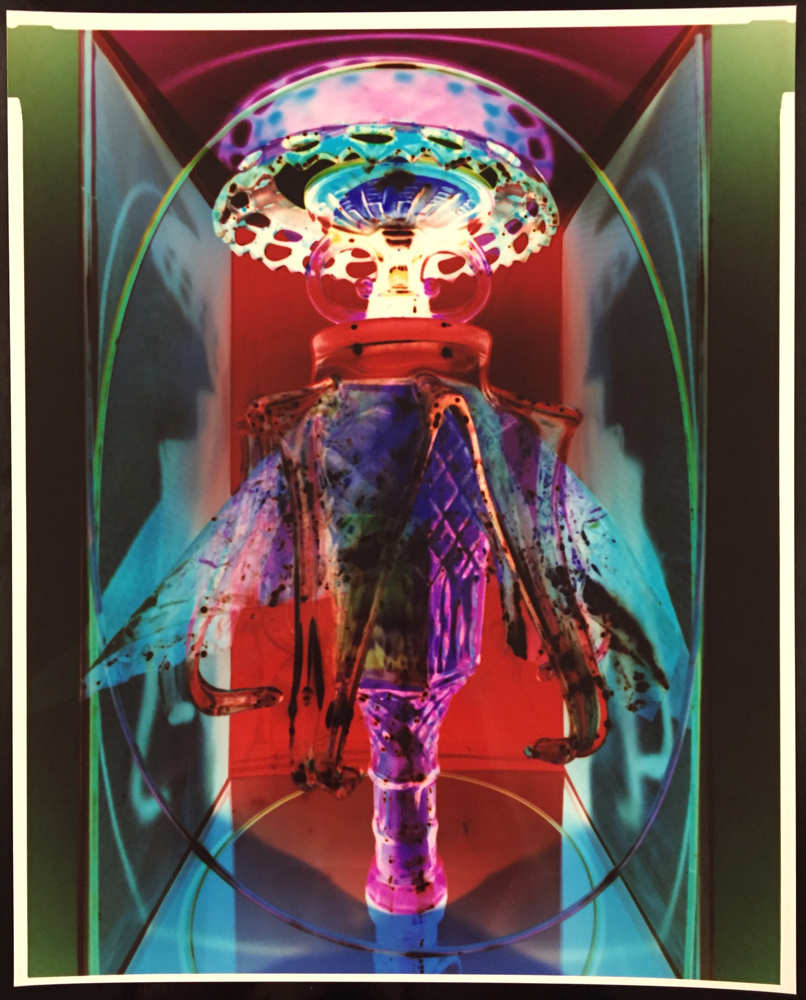
Still Life (2017-2018), 10″x8″ unique pinhole C-Type ©Robert Calafiore/courtesy ClampArt, New York
AL: The result of working with a positive photographic paper is that your photographs render in negative form. This produces some surprising and lushly wild color results. I wonder if you could say something about the extent to which you employ color theory, and if there are art historical figures or artifacts that have informed that part of your practice.
RC: The color is certainly one of the qualities about exposing the paper directly that I responded to immediately. It represented a lot for me but mainly my parents’ amazing life and the place from which they came. Of course, as I made more pictures, many other influences came into play. One of the most important would be Henri Matisse and his extensive work with objects in the studio. The repetitive use of objects over time, as well as the use of pattern and still life, has been inspiring. His relationship to the objects is fascinating and provided endless material, as it does for me.
AL: Between 2008 and 2011, you made a series of photographs on the human form. Can you tell me more about this project?
RC: This is how my work with the pinhole camera began. To be honest, I was unsure about what the series would become or what specific ideas would eventually emerge. I did sense that there was something there, and it excited me. These were luscious, indulgent, over-the-top, baroque, and decadent pictures that exposed my interest in the relationship between figure and environment. Influenced by art history, mythology, religion and my personal, sometimes intimate experiences with other people.
AL: Why did you change your subject so radically, from the human form to the still life?
RC: I was unsure where I was going with the figurative work. I needed some time to live with and think about the work I had made. The two subjects weren’t so different for me either. I am equally passionate about my relationship to both.
AL: Your choice of object for the still life studies is glassware. But it’s very specific isn’t it?
RC: Yes, as I mentioned earlier, this collection began with a few pieces from my parents and grew by taking pieces from everyone in my extended family and then friends. Most recently, the collection has been added to by way of purchase through flea markets, garage sales and antique shops.

Still Life (2017-2018), 10″x8″ unique pinhole C-Type ©Robert Calafiore/courtesy ClampArt, New York
AL: There’s also a wonderful abstraction—with both the form and temporality. How does this tie in to your creative and conceptual vision?
RC: I love the abstract passages that occur in the work. Though not abstract as a whole, finding the abstract moments in my work lends it some of the magical and otherworldly qualities that I seek to create. In transforming the ordinary to the extraordinary, abstraction within the pictures allows the subject to become more than it is. Hence the whole is greater than the sum of all its parts. Something new. Something iconic.
AL: You’ve said elsewhere that you make many more prints than what make the final edit. Is there a good amount of serendipity involved? Are you able to control the results more, the longer you are making the work?
RC: Yes, I have become much better at controlling results. However, I have always worked intuitively and find it important to my work to allow for surprises. Listening to the work and not getting stuck on what I had initially envisioned is critical. It still takes several tries with most set ups, but I am beginning to see some of those as variations and possibly something I can use in some way.
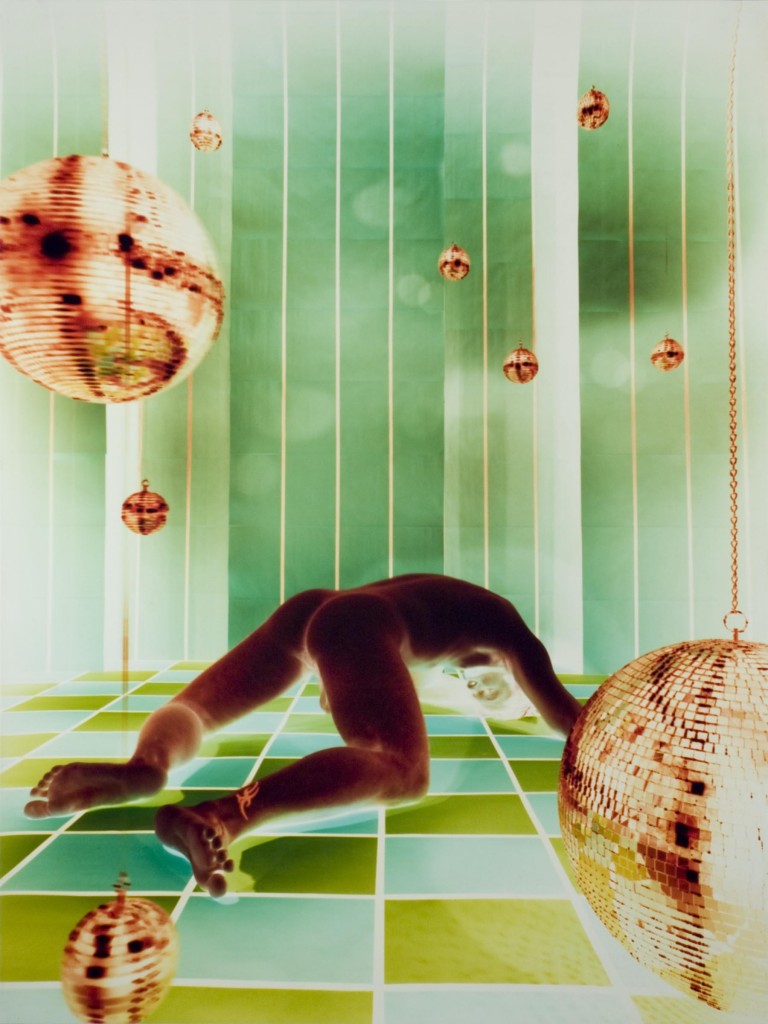
Untitled Figure (2008-2011), 40″x30″ unique pinhole C-Type ©Robert Calafiore/courtesy ClampArt, New York
AL: Are you continuing to work with still life—and glassware—or do you have other subjects you’ll be turning to?
RC: This summer I will return to working with the male figure. Given our current political climate and shift in cultural values, I feel like the work now has a more specific purpose. I will set out to embrace and promote our differences and provoke audiences to once again consider the benefits of those differences. And as has always been clear to me, in the end, we are more similar than different.
AL: People have really started to pay attention to you and your work. What have been the highlights for you, regarding this recognition?
RC: Wow! I still feel like I am dreaming. The most rewarding impact has been meeting so many fabulous artists, gallerists, writers, and industry experts. I have made countless new friends and connected with a whole new circle. The supporters and collectors are just wonderful. It has allowed me to continue to forge ahead with more work.
AL: Recently you exhibited at the ClampArt gallery in New York, where you’ve also attained representation. Anything else on the horizon?
RC: I am so very fortunate to have received exposure for my work. It is to be credited to many people like yourself, who offered support and opportunity over the last few years. I hope to work this summer and into early next year to finish a new body of work. Beyond the incredible relationship with ClampArt, I am working to get the work included in more reviews and critical essays as well as in front of curators who may find the work a good match for certain museum exhibitions and more.
Robert Calafiore lives and works in Connecticut, and is represented by the ClampArt Gallery in New York.
Tags: Art Interview, at length mag, ClampArt, Debra Klomp Ching, Klompching, Photography, pinhole, robert calafiore
Posted in Photography | No Comments »
Amy Jorgensen
Tuesday, August 15th, 2017
Amy Jorgensen, interviewed by Debra Klomp Ching, about the Something Old, Something New, Something Borrowed, Something Blue series.
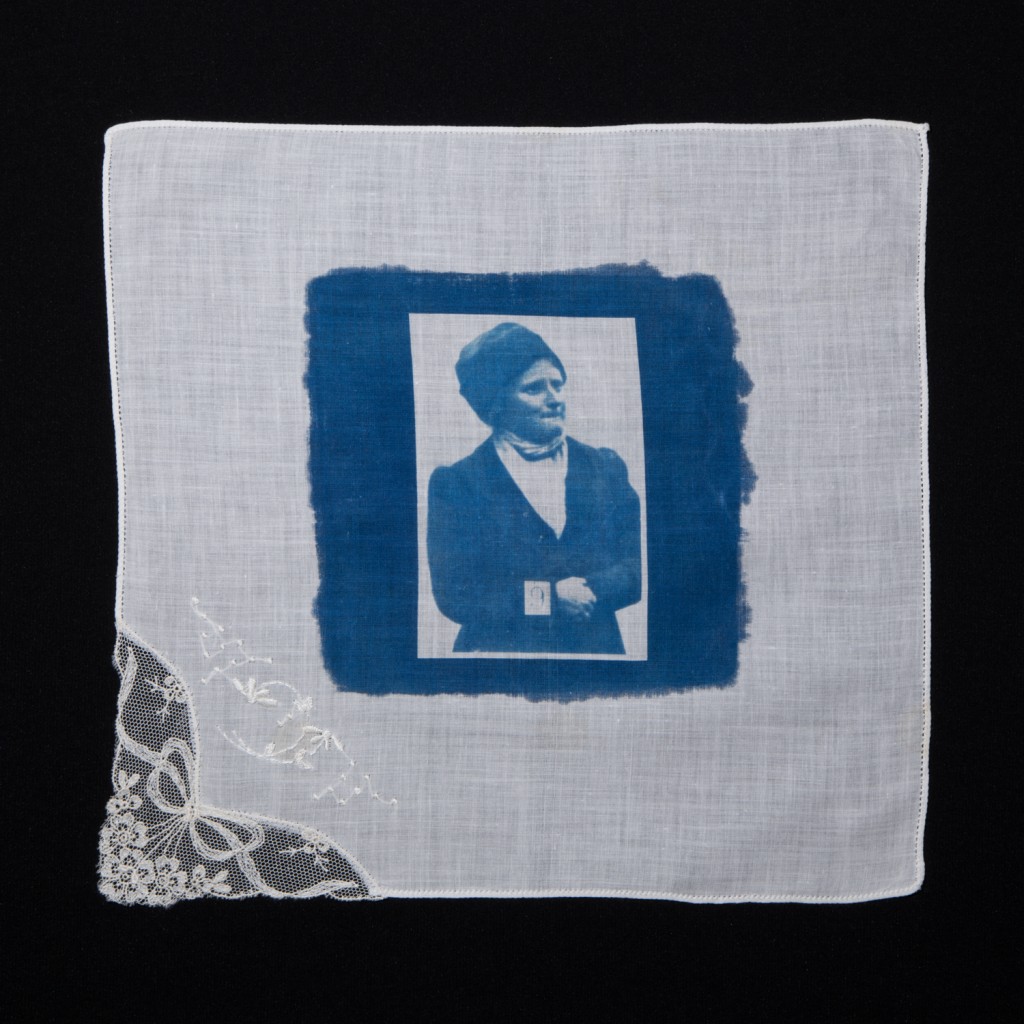 #9 Verity Oates (2016) ©Amy Jorgensen – 12″x12″ cyanotype on cotton handkerchief
#9 Verity Oates (2016) ©Amy Jorgensen – 12″x12″ cyanotype on cotton handkerchief
At Length: I was first introduced to your series Something Old, Something New, Something Borrowed, Something Blue when we met at the Maine Media Workshops + College, and then later viewed it in person at your solo show at the Elizabeth Houston Gallery in New York. Can you start off by sharing what the initial inspiration for your project was?
Amy Jorgensen: The initial inspiration for Something Blue was my Great Aunt Edna Berg, who was a suffragette in New York City in the early part of the 20th century. A curator had asked me to participate in a show exploring intergenerational female themes, and I knew immediately Edna would be the starting point for this new work. As I began researching the details of her life and the work of early suffragettes, I discovered the recently unearthed archive of surveillance images made by the Scotland Yard in 1913.
This is a collection of eighteen images made of women who were militant suffragettes in the UK during the early part of the 20th century—the end of the Edwardian era. Over a nine-year period, just prior to the first world war, approximately 1000 women were sent to prison for their activity in the suffrage movement. Most of the surveillance images were taken while the women were in the yard at Holloway Prison, and they are reportedly the first surveillance images ever made, as the suffragettes refused to pose for photographs.
AL: How important is your personal narrative, in the story that you weave through the series?
AJ: The stories in my family about Edna are legendary; as a young person she occupied mythical status in my imagination. I never met her and only know her through family lore, but while I was navigating adolescence as a self-identified feminist, she certainly served as a role model.
She marched in the streets, used to have tea with Eleanor Roosevelt, debated politics loudly and fiercely, and was a vocal advocate for the rights of women. And there are small connections. My family lived in Italy for many years, and my parents would spend whole afternoons sitting with the linen and embroidery makers in Portofino. They cultivated life-long relationships with the women and had a deep appreciation for the traditional craft. These experiences undoubtedly influenced the making of this work.
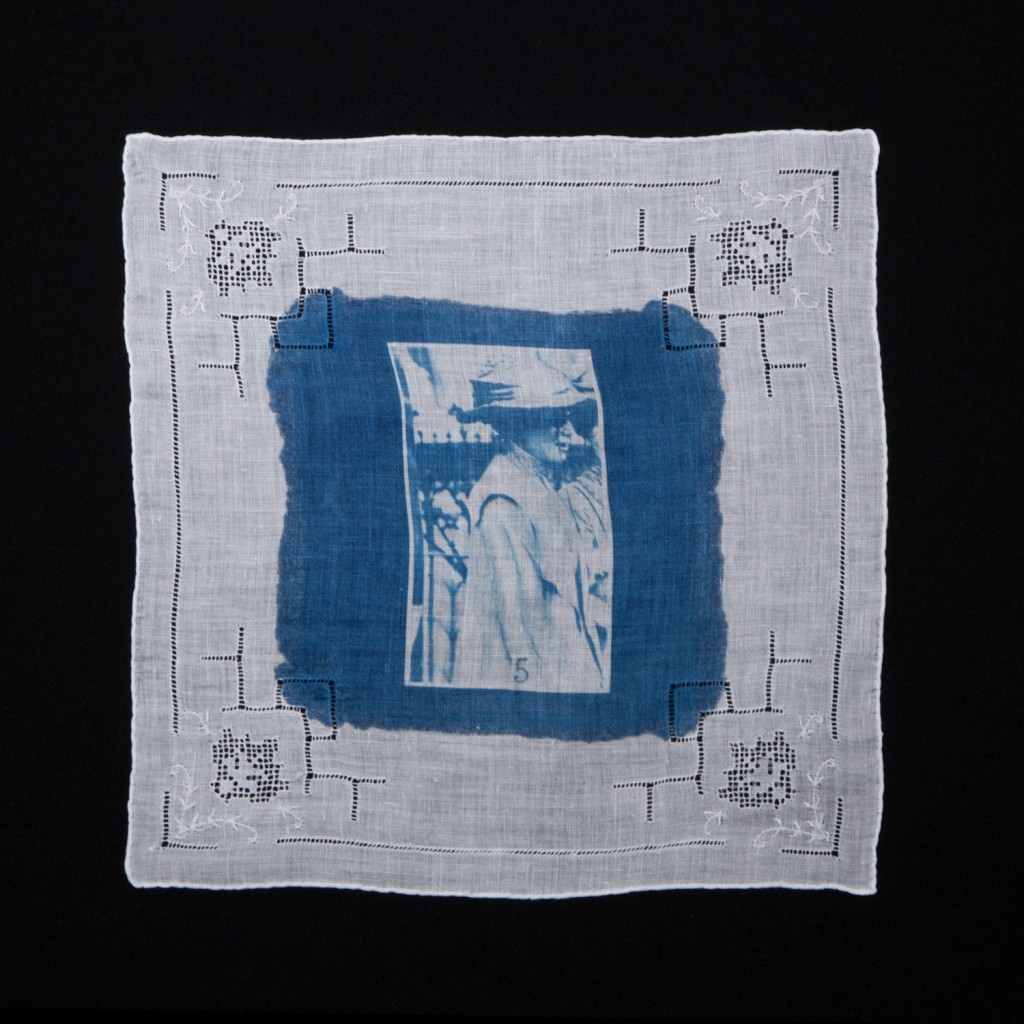 #5 Annie Bell (2016) ©Amy Jorgensen – 12″x12″ cyanotype on cotton handkerchief
#5 Annie Bell (2016) ©Amy Jorgensen – 12″x12″ cyanotype on cotton handkerchief
AL: The title of the work is a familiar catchphrase, obviously conjuring up the realm of the female, specifically brides and wedding rituals. Did the title come early on in the project and how did you arrive at it?
AJ: The phrase first appears in the written record in 1876 in England, as a rhyme associated with good luck and fertility for a bride. Over time, the folklore phrase has become institutionalized in the traditions of matrimony—every bride needs something old, something new, something borrowed, and something blue.
What I like about this phrase, whether you subscribe to it’s superstitious nature or not, is that the tradition is about a generational, intimate exchange among women. The bride is gifted various objects by mothers, grandmothers, and close friends to wear close to her body on the day of her wedding. A handkerchief is worn next to the skin, close to the heart, inside the bra, a garter belt on the thigh…. They are usually objects that are feminine, made by other women, and often passed down through women in families. It is a ritual of sharing and intimacy.
Historically, marriage was a transaction negotiated by men. A woman passes from her father’s household to her husband’s household, dowries are paid, and maiden names exchanged for married names. In the loss of one identity for another, neither of which is entirely her own, I was intrigued by the acts of intimacy shared between women and the many points of conflict associated with matrimony in terms of identity, equality, autonomy and power. The phrase seemed a perfect catalyst to explore confrontational and sometimes contradictory themes.
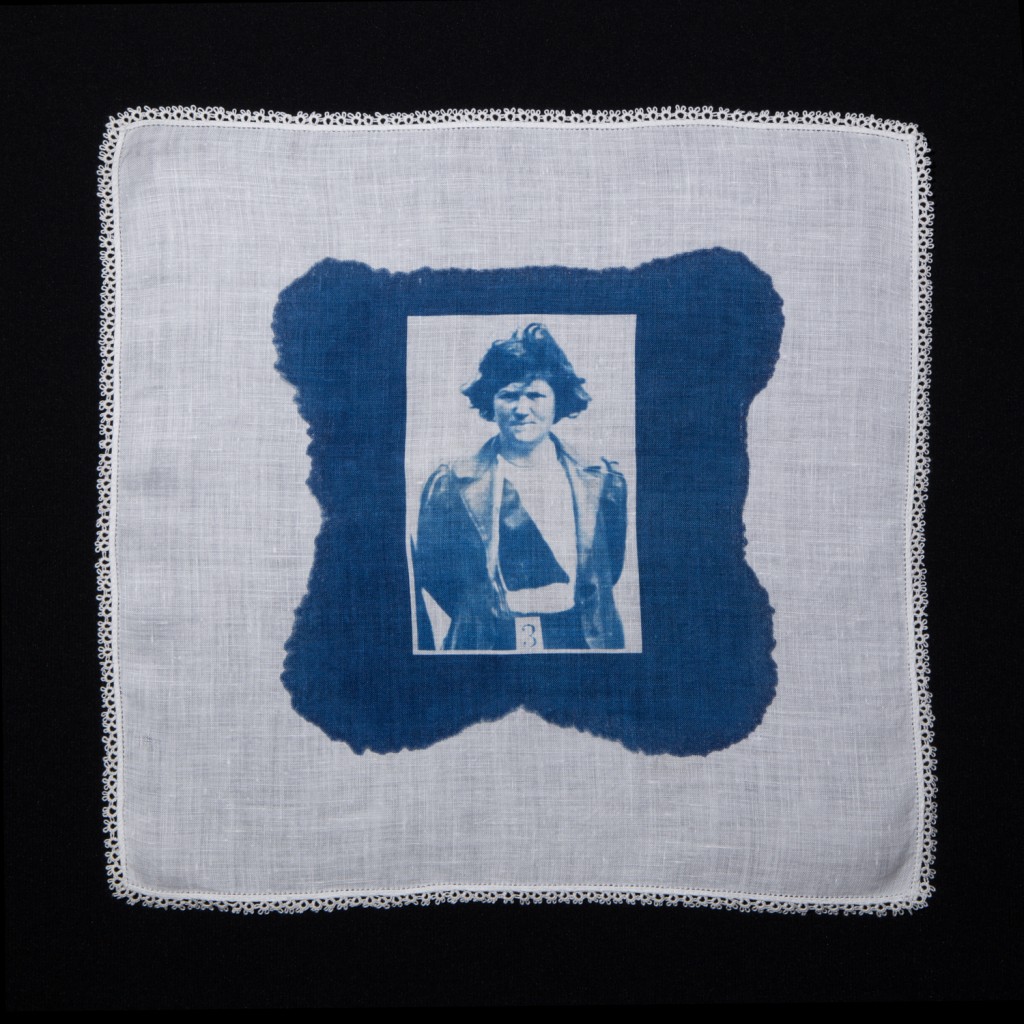 #3 Margaret McFarlane (2016) ©Amy Jorgensen – 12″x12″ cyanotype on cotton handkerchief
#3 Margaret McFarlane (2016) ©Amy Jorgensen – 12″x12″ cyanotype on cotton handkerchief
AL: This positioning of the work, firmly within feminist context, is further compounded by the materials used. Can you explain the meaning behind the combination of materials in this context—cyanotype, vintage handkerchief, archived imagery?
AJ: I chose the cyanotype process for a few reasons. It’s a historic 19th century process popularized by Anna Atkins, the first female photographer and the maker of the first photographic book. The cobalt blue is a deeply rich and seductive color, and because it’s a photographic solution that can be painted onto fabric, there is an element of the hand involved in making the image, in much the same way there is an element of the hand involved in the extraordinary embroidery work on many of the handkerchiefs.
Each surveillance image is printed onto a vintage handkerchief. These are objects that were made and worn by women, and often gifted for the wedding ceremony. Suffragettes commonly signed and exchanged handkerchiefs as a symbol of solidarity, using embroidery techniques to scribe their names or initials. In the 1970s a handkerchief surfaced with the signatures of 68 suffragettes imprisoned at Holloway Prison in 1912. Each name was embroidered, it’s an extraordinary document.
The parallel narratives of the matrimonial ceremony and suffragette surveillance imagery, provide a departure point to examine the role of patriarchal structures in history and contemporary culture.
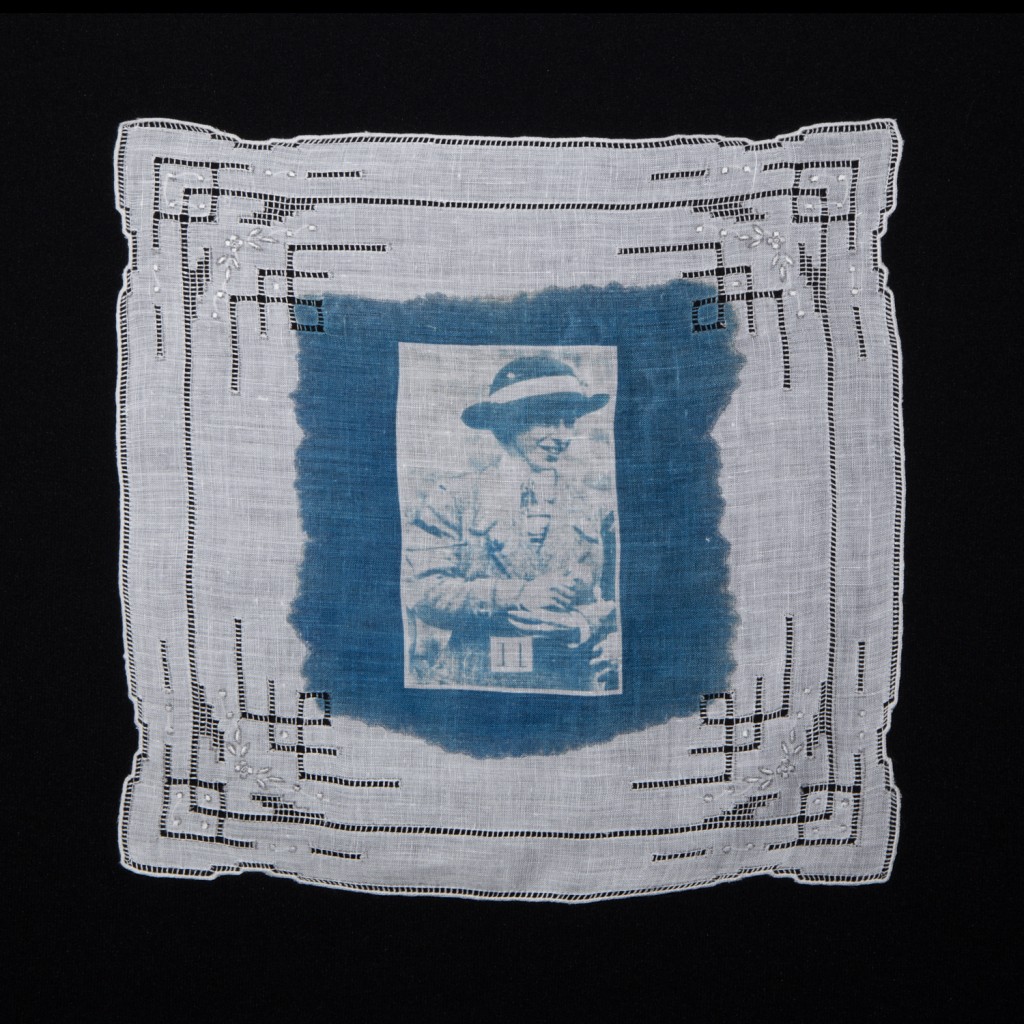 #11 Mary Raleigh Richardson (2016) ©Amy Jorgensen – 12″x12″ cyanotype on cotton handkerchief
#11 Mary Raleigh Richardson (2016) ©Amy Jorgensen – 12″x12″ cyanotype on cotton handkerchief
AL: How important are the identity and personal stories of the women depicted in the photographs? Is there a key figure that interested you when making this work?
AJ: The work makes sense if you understand the general experience of the suffrage movement: however, these women have such compelling personal stories the details of their lives certainly add depth to the series. They ultimately came to the conclusion that militant participation and civil disobedience (bombing, arson, vandalism) were the only way forward to secure the vote for women. They were arrested on multiple occasions, imprisoned at Holloway, force-fed, participated in hunger and thirst strikes, beaten, and lived under the cover of aliases. Their experience conjures the phrase penned much later by Pulitzer Prize-winning author Laurel Thatcher Ulrich in a text about colonial women, “Well behaved women seldom make history.”
Mary Raleigh Richardson (#11) was arrested for slashing Diego Velazquez’s “Rokeby Venus” at the National Gallery in London. She did so in defiance of the government’s treatment of Emmeline Pankhurst, the leader of the Women’s Social and Political Union. She stated, “I have tried to destroy the picture of the most beautiful woman in mythological history as a protest against the Government destroying Mrs. Pankhurst, who is the most beautiful character in modern history.”
Long before John Berger introduced the concept of male gaze into the art lexicon, there was an intuitive awareness of the power of the male gaze. It was this destruction of artworks by Mary Richardson (#11), Lillian Forrester (#14), Evelyn Manestas (#10) and Annie Briggs (not pictured) that triggered Scotland Yard to make the eighteen surveillance images.The printed images with corresponding numbers on each card were handed out to detectives and gallery staff, an interesting historical parallel to the most-wanted playing cards used during the US invasion of Iraq. Surveillance, by construction, is inherently about the act of looking, and the first surveillance images ever made, were created because a woman acted in violent defiance of the male gaze.
In another example, Jane Short (6)—an alias for Rachel Peace who was an embroiderer—was force-fed three times a day for several months during a hunger and thirst strike. The experience left her in a fragile state and she spent the remainder of her life in and out of asylums. A well-to-do member of the Women’s Social and Political Union, Lady Constance Lytton, took responsibility for her life-long care. I was struck by the suffering of so many of these women in prison as they were violently restrained and force-fed, but also by the solidarity they shared as a community.
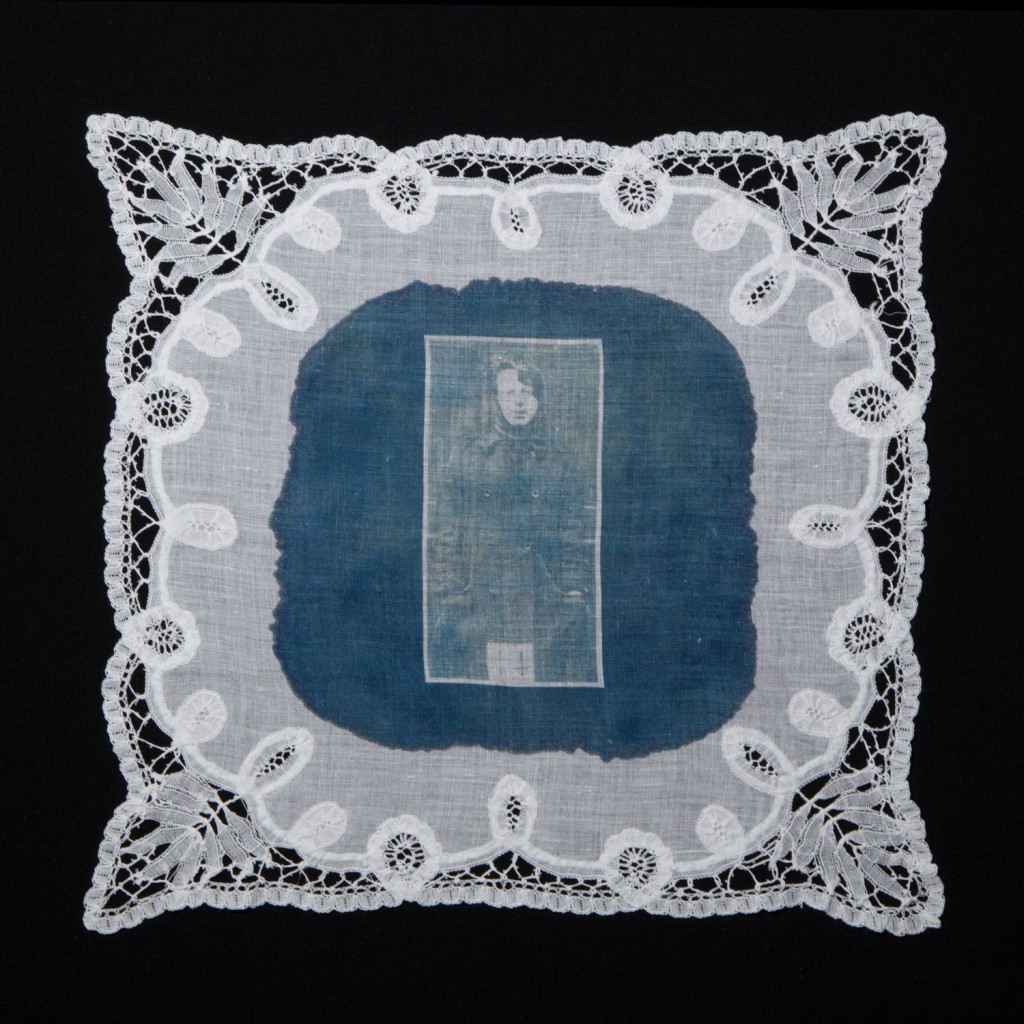 #14 Lillian Forrester (2016) ©Amy Jorgensen – 12″x12″ cyanotype on cotton handkerchief
#14 Lillian Forrester (2016) ©Amy Jorgensen – 12″x12″ cyanotype on cotton handkerchief
AL: How and where do you find the handkerchiefs? Do any have a personal connection, for example, belonging to a female ancestor?
AJ: In the early printing stages all of the handkerchiefs were sourced from friends and family members, so each one was an heirloom object passed through the family. However, after a while I began to exhaust that resource; not everyone wants to give up all of their great grandmother’s hankies. So now I scour online estate sales and E-bay. However, I do make sure every edition includes a few heirloom handkerchiefs with a known history, as it’s an important part of the project for the objects to convey intimacy, both through their physical presence and lived history.
AL: There’s also an undercurrent of the taboo aspects of the female condition—widely explored within feminist art—that bind the female to her gender. For example, the use of the cyanotype on the handkerchief is reminiscent of menstrual flow on cotton. Is this connection a reach, or do you see this as an additional layer of the series?
AJ: Much of my work is situated in conversation with the body. In this series one can think of the handkerchief or cloth as being akin to the body, in both spiritual and feminist terms. Historically in visual art, the female body is most often acted or gazed upon, whereas I am interested in exploring the body as active and participatory. As the cyanotype solution spreads and soaks into the cloth, it mimics the staining of blood during the menstrual cycle. And while the cobalt color is obviously different, the patterning, saturation and mottledness of the final image is meant to convey a link to bleeding. The act of making this reference is a confrontation of the taboo, as much as women’s experiences outside of what conforms to convention remains unseen and unspoken.
AL: And of course the cultural/conceptual space of domesticity is visible.
AJ: Absolutely. On one hand this work is very much rooted in the domestic realm, the handwork, matrimony…. Yet there is also pushback. While the materiality of the project is very feminine it raises important questions about the cultural and economic value of women’s work, and perceptions of domestic ritual and space. The delicate object, or the domestic space, can also function as a form of protest and confrontation.
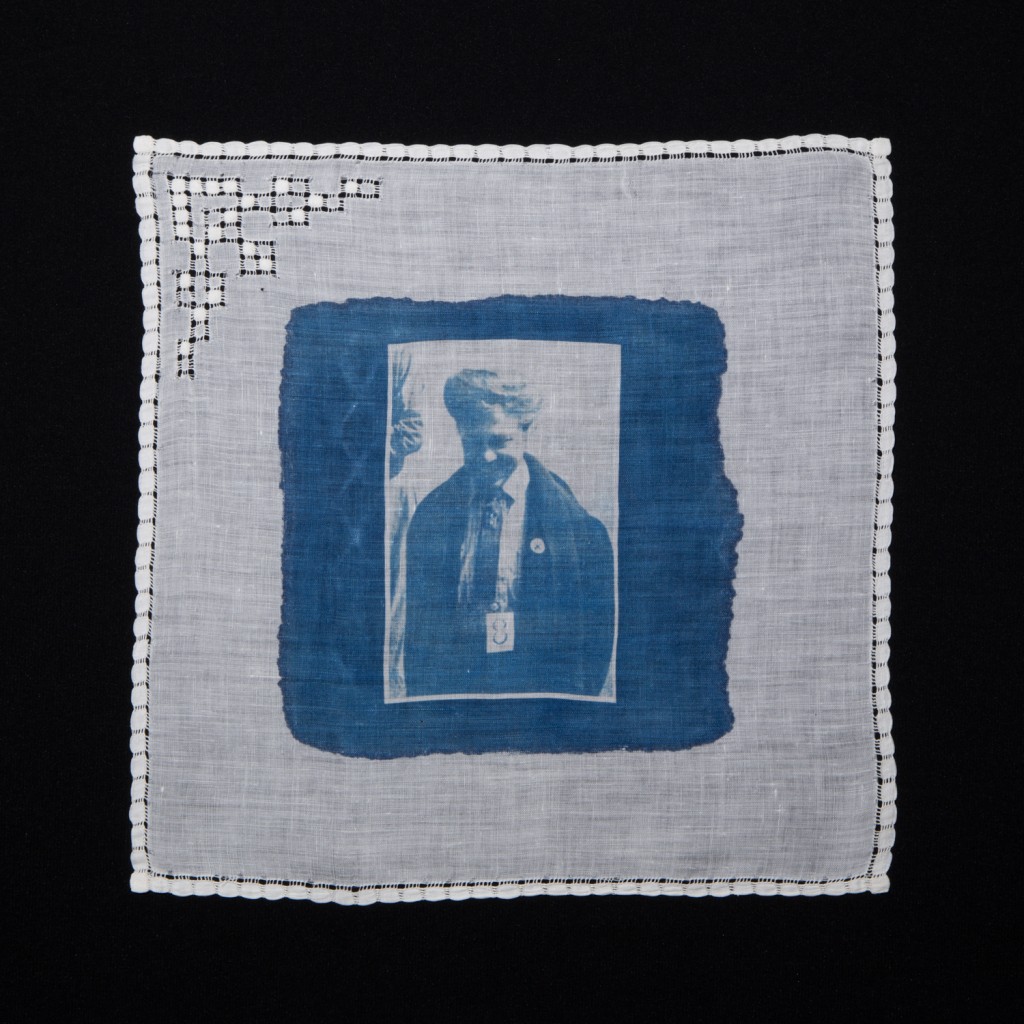 #8 Maud Brindley (2016) ©Amy Jorgensen – 12″x12″ cyanotype on cotton handkerchief
#8 Maud Brindley (2016) ©Amy Jorgensen – 12″x12″ cyanotype on cotton handkerchief
AL: Each photograph is unique, printed by hand onto an individual handkerchief. The labor of your hand is evident in the application of the cyanotype solution. Is this evidence of authorship important to you? How does this relate to the subject?
AJ: If we return to the title phrase, Something Old, Something New, Something Borrowed, Something Blue, it’s about connection and exchange. I see the application of the cyanotype solution, by my hand onto the handkerchief, as another layer of exchange and intimacy embedded into the object. The embroidery, the white work, the lace: All of this work was traditionally done by the hands of women. In brushing the cyanotype onto the handkerchief, in leaving the mark of my hand, I see myself contributing to the history of the object. A gift, if you will, to the next person who holds it close.
AL: When you exhibit the work, the handkerchiefs are pinned to the wall. How does this form of presentation add to the overall concept and message of the work? Are the pins dressmaker pins by any chance?
AJ: The handkerchiefs have an exquisite delicateness and materiality to them. In the exhibition context, each handkerchief is pinned to the wall in the upper corners with small pearlized dressmaker pins. This allows gravity to pull on them slightly, creating a soft sway in the material, giving them dimension and tactility. Because there is so much detail in each handkerchief viewers like to get close to them, and someone’s breath or movement in the room creates a reactionary movement in the handkerchiefs. I wanted the work to feel alive so that the connection between past and present becomes fluid. For collection and permanent hanging, framing and glass sometimes becomes necessary, but there is an element that is lost when they are placed behind glass. Handkerchiefs were designed to be held.
AL: The series is editioned as unique artworks with variations. How many pieces are in the series and how are collectors buying the work? Is it in pairs, multiples, singles?
There are eighteen images in the series, and it is editioned as 5 + 2 AP with variations. Every handkerchief is different, and the staining of the cyanotype chemistry is unique to each one. The primary interest is in individual images—I think people identify with a particular suffragette’s story or image.
AL: Have you printed the complete edition, or do you continue to print over time? Why is this?
AJ: I print the editions over time, really out of necessity, as it takes so long to source the handkerchiefs. In every collection of eighteen I like to have a combination of old, new, and borrowed pieces, including a few heirloom pieces with a known history. I also think about how the physical characteristics and aesthetics of each handkerchief pairs with the images and histories of individual suffragettes. It’s partly intuition; sometimes I simply know that this suffragette must be on this handkerchief. And lastly, I look at the collection as a whole. There is a lot of shuffling around on large tables to find the right balance.
 #10 Evelyn Manesta (2016) ©Amy Jorgensen – 12″x12″ cyanotype on cotton handkerchief
#10 Evelyn Manesta (2016) ©Amy Jorgensen – 12″x12″ cyanotype on cotton handkerchief
AL: What are the common responses to the work? Who is responding most effectively—curators, critics, photo editors?
AJ: To date, the most effective attention is coming from photo editors, who recognize their audiences are interested in themes of surveillance, power, suffrage and the relevance of these issues today. The work resonates strongly with contemporary women, regardless of where their personal politics fall on the spectrum of conservative to liberal. I think they identify on an intimate level with both the historical struggle of the suffragettes, and the current dialogue surrounding women’s equality.
A couple of art dealers have posed the question of the art market. More specifically, art about women does not sell; men buy most of the art, and men don’t buy art about women. This speaks to the heart of what Something Blue is about—changing the structures of patriarchy and equality for women. It is a question surrounding the value of domestic space and work. There is still much work to do.
AL: Where would you like to see this series situated in the long term? For example, it seems that the artworks could easily find a home in a museum’s photography collection, a collection on the history of the struggle for women’s equality, etc.
AJ: I would ideally love to see a complete set of eighteen collected by an institution with a specific focus on women’s art or women’s history. Conceptually, I like the idea of the work being viewed in a broader context of the women’s movement.
AL: Do you have any exhibitions planned for the future?
AJ: I have a solo exhibition in the fall and am putting together new work exploring the intersection of violence, power, and the body. My research into the early militant and radical practices of suffragettes has certainly informed this new work and I’m excited to see how it unfolds.
Amy Jorgensen is a visual artist working across photography, performance and video. She lives and works in Utah, United States.
Tags: Amy Jorgensen, Art Interview, at length mag, Cyanotype, Debra Klomp Ching, Feminist, Interview, Klompching, Photography, Suffragettes, Women In The Arts
Posted in Photography | No Comments »
Bill Durgin
Wednesday, November 2nd, 2016
interview by Darren Ching and Debra Klomp Ching
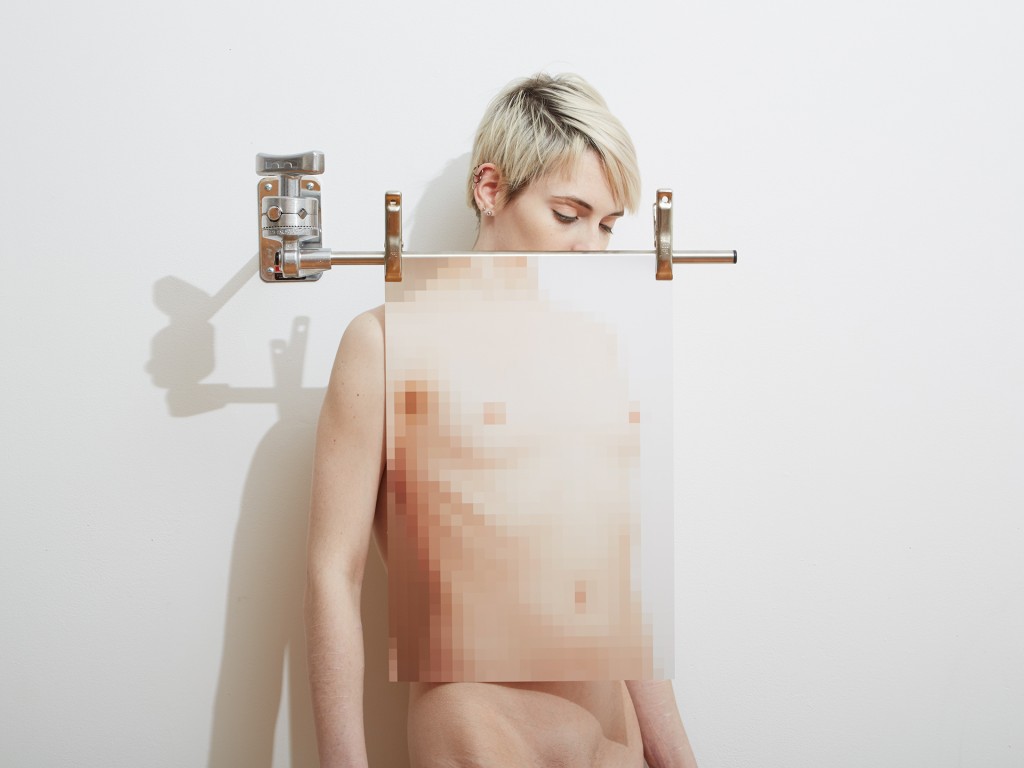 Adrian With Mosaic, 2015 © Bill Durgin
Adrian With Mosaic, 2015 © Bill Durgin
At Length: Your photographic practice, as a whole, engages with the human body. What initially inspired you to make this the focus of your practice?
Bill Durgin: I’ve always been fascinated by how the physical body how ages, the virtuosity of athletes, dancers, performers, and just how people inhabit space. For years I was reluctant to photograph the body as I wasn’t interested in the figurative photography work I’d seen. While working on an earlier series of narrative-based images, I became less fascinated with the before and after of the scene I was creating and more interested in creating something singular, something that did not have a before and after, something that existed only in one frame. It couldn’t be perceived as part of a scene that you would come across. This idea came to me of a torso draped with no arms or legs. I wanted to see if I could image that. I’d originally thought I would have to do it in postproduction, but while working with a friend who is a dancer, I realized how through contortion and perspective I could create this sculptural view in camera. I was hooked.
AL: The Fresh 2015 exhibition featured photographs from the “Studio Fantasy” series. Can you tell us more about this work—especially in terms of how it emerged from your previous series?
BD: While I was an undergrad at the School of the Museum of Fine Arts, I saw a television ad for Lagerfeld Photo eau de toilet. It showed a photo session in a shabby chic loft with a stereotypically beautiful model shooting with a stereotypically handsome photographer, no other production staff. Shot in black and white, very diffused, the shoot was a flirtatious dream sequence. At the time I was working in commercial photo studios and the school’s darkrooms, sweating, getting dirty, smelling of chemicals, schlepping equipment, enduring the demands of anxiety-inducing production schedules…. I loved the irony of it, seeing the photographic shoot portrayed as fantasy while working in its much less glamorous reality.
https://www.youtube.com/watch?v=pbS2ha5IQLY
I was reminded of this while shooting head shots for a friend. He brought a bottle of wine and offered me some. While I do love wine I can’t drink while I shoot and said so; there are too many variables to focus on, and I’ll inevitably mess something up. He was surprised and said he had a completely different picture of what I did on a daily basis. When I realized that even my friends had this fictionalized glamorous view of my studio practice the idea for Studio Fantasy came immediately. Unlike other series the name came first, and I started showing the edges of the sets and some of the banality around studio practice. In my previous bodies of work I carefully composed each image to avoid stray objects and supports. This series put those in the forefront. I wanted to depart from the set of rules I had laid upon myself, freeing up my technique and exploring some new ideas while still investigating new ways of imaging the body.
 Fake Wine Spill, 2015 © Bill Durgin
Fake Wine Spill, 2015 © Bill Durgin
AL: In this body of work, you have maintained the human form as a central focus, but also incorporated photographs of objects without bodies. Why is this?
BD: Still lifes in the series are about making the banal beautiful, elevating studio tools and props to be the primary subject. Using gaffer tape to make a graphic tonal composition, the beauty of a plastic bag suspended from a C-stand, apple boxes leaning against each other with a print that visually erases one, a fake wine spill shot to reveal its inherent farce.
AL: In many respects, then, the studio, along with its various props, has emerged as a key subject. Can you tell us more about how you’ve explored this?
BD: “If I was an artist and I was in the studio, then whatever I was doing in the studio must be art.” – Bruce Nauman
The studio, specifically my studio, is the key subject in this series. Aside from the obvious titular reason, I’ve been interested in the labor of studio practice. I have always revered Bruce Naumans’s approach to working in the studio, going there everyday working through the boredom of being alone all day and making that the work. Also his approach to creative blockage, “It generally goes back to the idea that when you don’t know what to do then whatever it is you’re doing at the time becomes the work.” – Bruce Nauman
I use the studio as a blank slate from which to build an image. There were certain rules I set as my work working method: show edges of the set or parts of the studio, use minimal props, a single bare bulb light source, include any tool used including color charts. I start with an empty studio area and bring in whatever support catches my eye that day. When working with a model, I’ll direct them to where the focal point is and then we’ll improvise and refine a pose. I’ll then take part of that image, pixelate it, print it, then bring that back into the set and continue improvising and refining.
 Priscilla With Color Checker, 2015 © Bill Durgin
Priscilla With Color Checker, 2015 © Bill Durgin
AL: It’s not just the studio that you examine, but this notion of the photographic space as well. What visual devices have you employed to examine these ideas?
BD: The camera itself is an editing tool; you are creating a visual space and omitting anything outside of the edge of the frame. The lens has a singular monocular view, which I exploit to achieve my composition, showing and hiding parts of the studio, the set, and sometimes the figure. “Studio Fantasy” is about making a photograph, not a documentary of what happens during the shoot.
I was looking at a lot of sculpture throughout this series. While I do see much work in person, I would always be looking at photographs of it in my studio. I was taking inspiration not just from the sculptures themselves but how they were translated into the photographic space. I treated my sets as a sculpture and documented them from a very specific perspective.
AL: The use of the pixilation appears to be a nod toward contemporary image consumption, through platforms such as social media, for example, but we wonder if there is something else going on. Can you expand on this element of the work?
BD: I saw an image on Instagram where someone had pixilated part of a body to fit the Community Guidelines. I was drawn to how the image looked more like a beautiful collage than a censored image. I could never find the image again, and perhaps it’s just the memory of that image that inspired this direction. I was drawn to the idea of using a form of censorship as a tool for incorporating a different dimensional plane within an image, like a collage. It also became a new way of abstracting the body and calling attention to the aspect of nudity rather than hiding it. The viewer becomes very aware of what is seen and what isn’t.
AL: How do you want your work to be received or understood in this context?
BD: I want the pixilation to be seen as a form of collage. I first saw it used in television news as a way to keep persons and incriminating documents anonymous. It was also sometimes used to hide nudity, often streakers at sporting events. Now I see it most often used on social media for the purpose of obscuring nudity, especially on Instagram. While I use it as a compositional tool, I also enjoy that it references anonymity and censorship.
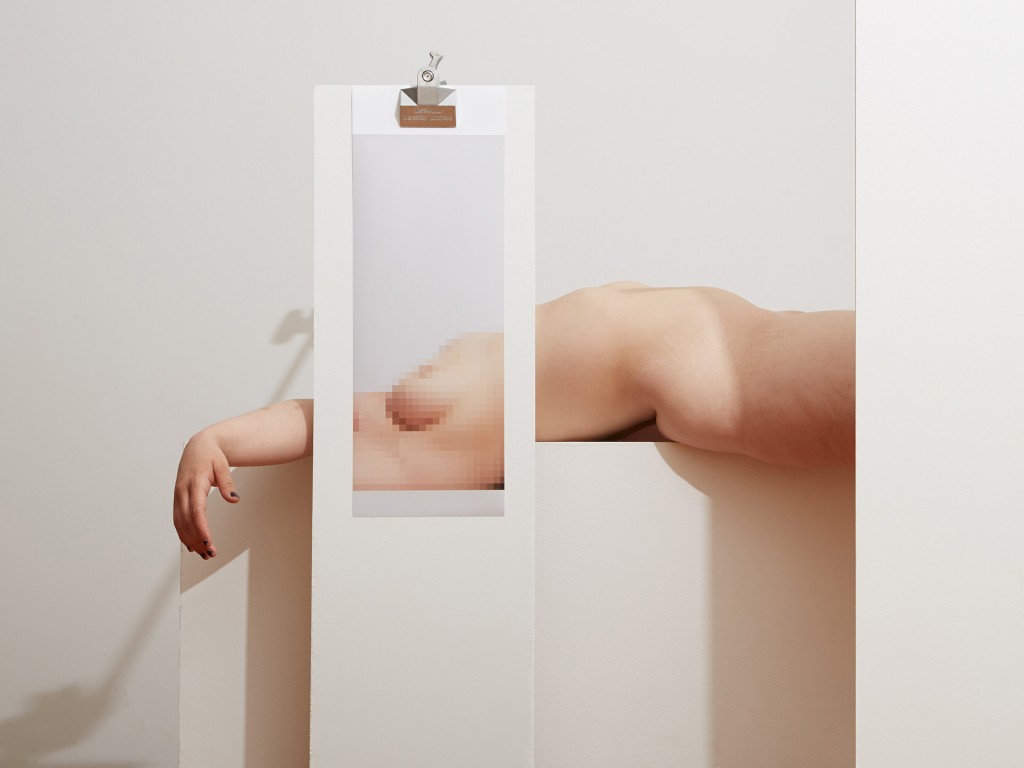 Jen With Mosaic, 2015 © Bill Durgin
Jen With Mosaic, 2015 © Bill Durgin
AL: Overall, your practice presents itself as disciplined, formal, rigorous. How do you go about making what you do? What is your process?
BD: I usually start with a bare studio and an idea. That idea could be a sculpture I saw, a pose in a painting, a new piece of equipment in the studio, or just a piece of plywood leaning against the wall, and more often than not it is a combination of props and a pose. This idea is a launching point, something to set up before the shoot begins. When I get on set with the subject, a model, prop or myself, improvisation takes over. I select an area to be pixilated, print it out and bring it back into the set when improvisation takes over again. I’ll often have to do several prints, try different supports, a constant back and forth between staging the new set and improvising with it.
AL: Do you view your practice as a formal interrogation of the subject? If so, what are the key qualities or concerns that thread the different bodies of work together?
BD: My work is more of a personal interrogation of the subject(s). While there are definitely formal issues investigated, representation, figuration, compositional strategies, theories of perception, there’s also very personal motives and emotional content within the images. I’d say that the main elements that go through all my bodies of work are image construction and a constant push for the new ways to image the body through various formal and personal perspectives.
AL: Would it be fair to say that the “Studio Fantasy” series interweaves several theoretical/conceptual notions? For example, the photograph as constructed and mediated, the labor of the hand, scopic illusion and so on?
BD: Definitely. Since the beginning I’ve always focused on constructing photographs; it’s just what I’ve been drawn to do, and with each body of work a new set of concerns gets added: historical context, both photographic and art historical; the use of camera angle and perspective, and the gaze created by that perspective; studio labor; body image; photographic space as partial truth. Some images address more concepts than others, and “Studio Fantasy” brings in ideas of creating images in a digital age while the construction of those images finds its core in hands-on studio technique.
AL: The color palette of the series is very restricted, why is this?
BD: I wanted the studio to be the ground from which these images emerged, so that determined the palette. Being a minimalist, adding color wasn’t a concern. I guess my studio just isn’t very colorful.
Self Portrait, Gray Card and Multiclip, 2015 © Bill Durgin
AL: It’s also somewhat quieter than your previous work, less risqué. Do you think this helps to make photographs more accessible and palatable to art collectors? Or, if this not a concern or conscious shift?
BD: I actually thought this work was more risqué, bringing the topic of nudity right to the front. Perhaps the bodies are more recognizable, but there was no conscious effort to make anything more palatable. I wasn’t thinking of sales while making it, just ideas and experimentation.
AL: Following the Fresh 2015 exhibition, you were shortlisted for the Aperture Portfolio Prize. What impact has this exposure had on your success as an artist, and what is next on the horizon?
BD: It was an honor to be in Fresh 2015 and shortlisted for the Aperture Portfolio Prize. I definitely had a bump in exposure, but most of all it is validating as an artist to be recognized for your work. This was a new direction for me, so it has encouraged me to continue expanding, growing and experimenting with my work. Right now I’m working on a series entitled “Figure-Ground,” stemming from the principal in gestalt theory that a figure is perceived through its distinction from its background. I am layering several images from a single shoot, partially erasing and layering figures, blurring the boundary between what is figure and what is background.
Tags: Bill Durgin, Fresh2015, Interview, Klompching Gallery, Photography, Studio Fantasy
Posted in Photography | No Comments »
Peter Croteau
Wednesday, July 1st, 2015
interview by Darren Ching and Debra Klomp Ching
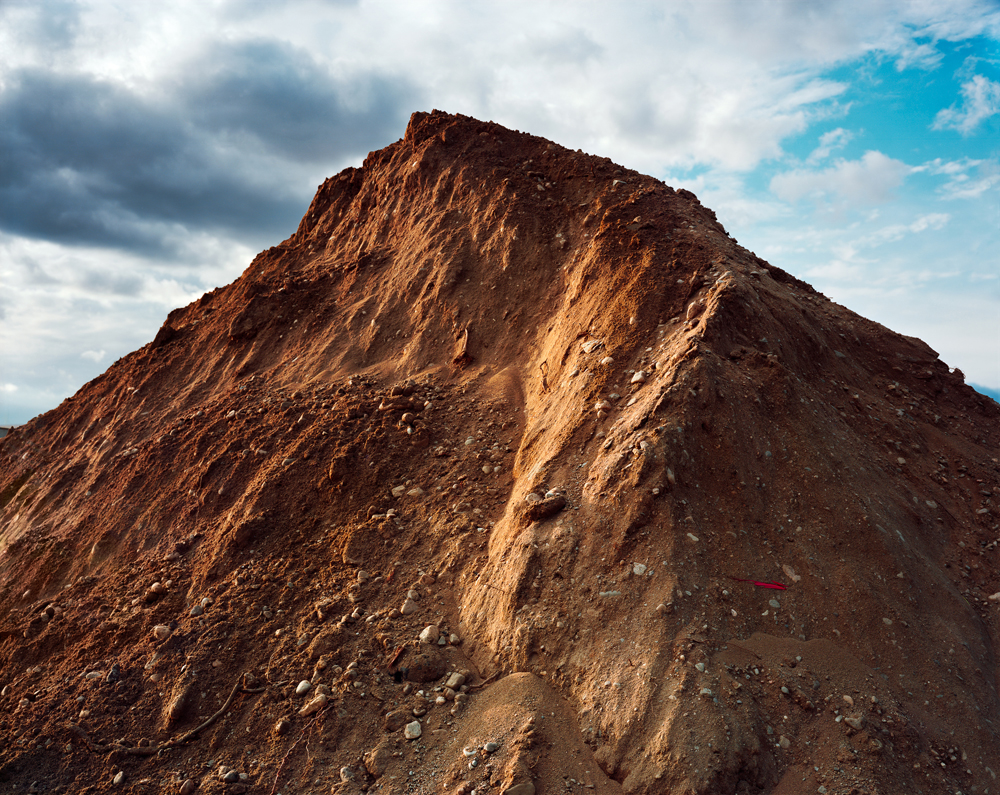 Mountain I, 2012 © Peter Croteau
Mountain I, 2012 © Peter Croteau
At Length: How did you start the “Mountains” project, and what was the inspiration?
Peter Croteau: The project began while I was in graduate school at RISD. In my work I explore the in-between spaces in the landscape, otherwise known as spaces of dross. During this time I was attempting to shift my process and see the everywhere-nowhere spaces I had been photographing in a new way. The shift occurred when I was photographing piles of snow at night. I was interested in the liminal quality of snow, and the strange contrast snow has with the night sky under parking lot lights.
One of the photographs I came back with was different from the others. I had moved in on the space, and the camera frame had been transformed into something ambiguous—something that could be from another world. This ambiguity was an exciting new way of representing the landscape for me, and I decided to return to many sites of dross that I had been photographing, to attempt to transform them into something other.
One of my main inspirations for the project was Joe Dealʼs last body of work, West and West. Deal became tired of the amount of photography that replicated New Topographics aesthetics and only focused on manʼs impact on the earth. He felt that photographs of suburbia, and man-inflicted landscape, are in danger of becoming too familiar and easily dismissed.
With the oversaturation of images of ravaged landscapes comes a sense of complacency in the amount that we consume from the land. In West and West, Deal decides to turn the other way and re-imagine the Great Plains as how they may have been before we were there, as he imagined them as a child.
I found this act of reimagining the world key to my process as I began reframing spaces of dross. I found the process of turning a mound into a mountain was an act of reimagining the landscape as a wild space.
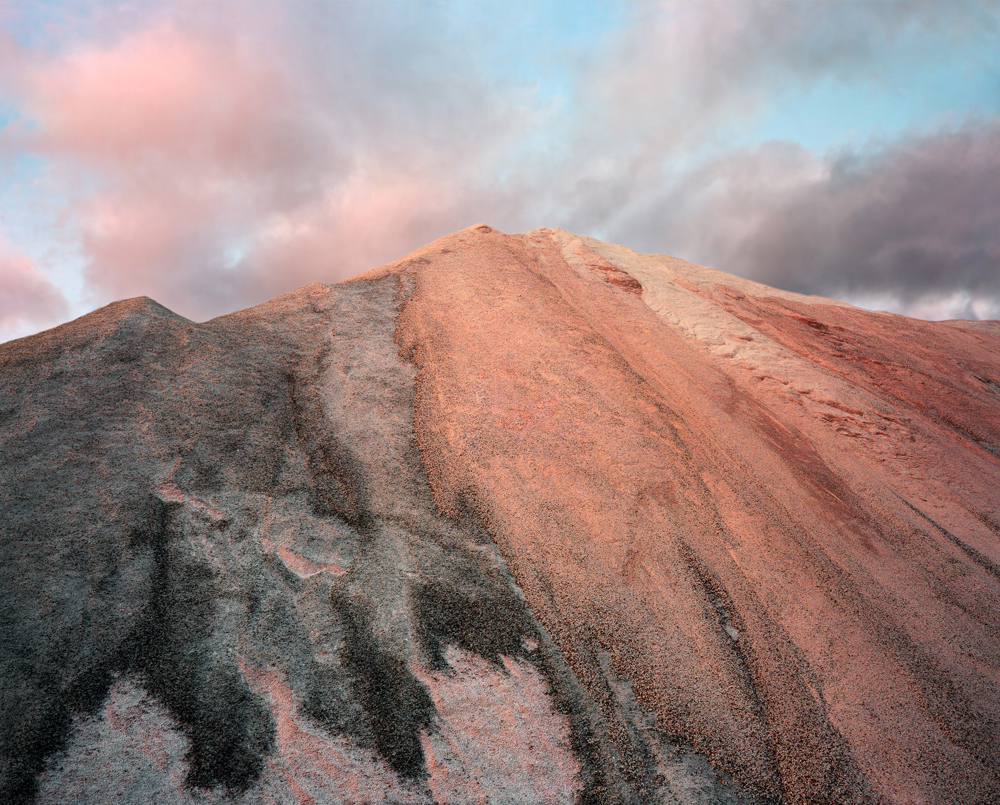 Mountain II, 2012 © Peter Croteau
Mountain II, 2012 © Peter Croteau
AL: One of the first impressions of the photographs is one of monumental grandeur, juxtaposed with ambiguity regarding scale. What statement are you making with such a bold and confident portrayal of seemingly banal mounds of dirt and rubble?
PC: From my photographs I’d like people to take away the idea that nature isn’t just a physical thing, but also a state of mind that we can expand to include more elements than just grand and distant spaces. Nature can include what is right outside our back door. We need to look at our own surroundings—whether urban or rural—as natural ecosystems. We need to factor how man, space and other life forms fit together rather than see ourselves as estranged from the natural world.
I attempt to accomplish this by turning mounds into seemingly wild spaces shaped by the hand of God, only to have the viewer realize that it is in fact the human hand that does the shaping. Humans create these ready-mades for me to transform. This transformation asks viewers to question what constitutes sublime, wild space. Through my reframing of these transitional spaces I want to show how humans shape, build, destroy, and regulate the landscape through capitalistic systems.
If this free will were to be fully realized and society could moved beyond a desire to simply accumulate wealth, then we could begin to understand just how we need to shape this world. This may open possibilities for new designs and life styles, allowing us to coexist with the world in a state of balance.
AL: Does the ambiguity of scale also extend to the actual geographic locations of the photographs? In other words, could they be anywhere or somewhere specific?
PC: The ambiguity of the objects I photograph extends beyond actual geographic locations. The viewer is not supposed to know where the photograph was taken, but is allowed into a space where they can make their own assumptions about where in the world they are. The sites I photograph are so commonplace that they are everywhere and nowhere.
 Mountain III, 2012 © Peter Croteau
Mountain III, 2012 © Peter Croteau
AL: How was it that you selected the locations? Are they places that have some personal or other significance?
PC: Most often the sites I photograph are something I see when driving, and then return to at a specific time of day. The only personal significance they hold for me is that I am drawn to site of the in-between. Having moved over a dozen times in my life, there has always been a sense of dislocation in my life. I feel an affinity to the everywhere/nowhere quality of these spaces. Beyond personal affinity, I am interested in how problematic—but necessary—spaces of dross are, and how they speak to our economic relationship with the land of mass consumption and sprawl.
AL: In some respect, the landscapes you’ve depicted seem innocent and natural; it’s only with closer scrutiny that visual hints indicate human intervention. Is there a fine line that separates the two?
PC: Humans have made this fine line exist. I am trying to break that line between what we see as natural and what we see as manmade.
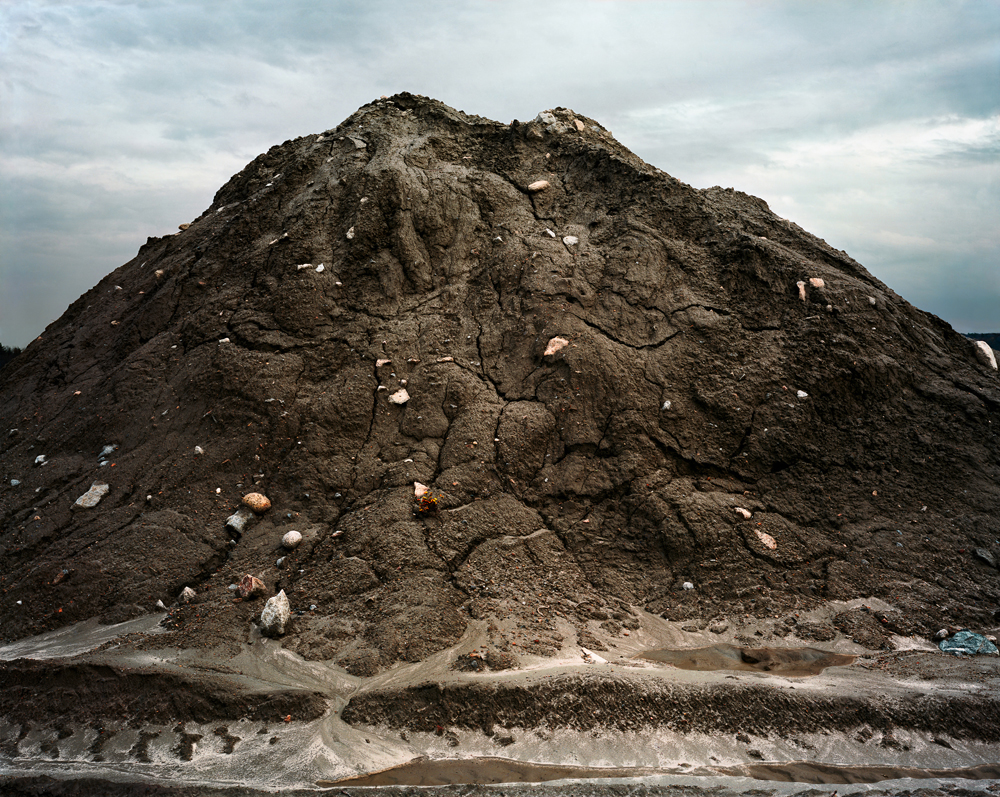 Mountain IV, 2012 © Peter Croteau
Mountain IV, 2012 © Peter Croteau
AL: What do you want the viewer of your photographs to see?
PC: I just want my viewers to be caught in a moment of ambiguity, where they are forced to question: What is reality? What is nature? And how do I relate to them? I want them to question the existence of the mountains and likewise ask their existential questions of themselves.
AL: The photographs display a formal composition. Why have you photographed them in this way?
PC: I have studied a history of landscape representation and employ many formal tropes from photographers and painters. More specifically, I am using the tropes of the Hudson River School painters, who depicted the American landscape as a vast beautiful land that was ripe for the taking under the philosophy of manifest destiny. By framing dross in relation to these historic painters, I am drawing up a dichotomy between the expansive landscape of dross that exists now and the wild frontier of the American West.
AL: Despite their formality, or perhaps because of it, the mood is very stoic and melancholic.
PC: In my attempt to make the unexceptional spaces in the landscape look like somewhere fascinating, the mood is very important. Getting my camera down as low as I can, and looking up at these objects in the landscape, creates a sense of monumentality and stoicism in the objects. Through my use of lighting and other weather factors, I attempt to draw mood out of the stoic forms. This mood can range from a deep melancholy to one of excited beauty. Use of lighting and weather to bring out the mood of the objects is one of the most important aspects for making these photographs believable—as distant, sublime spaces.
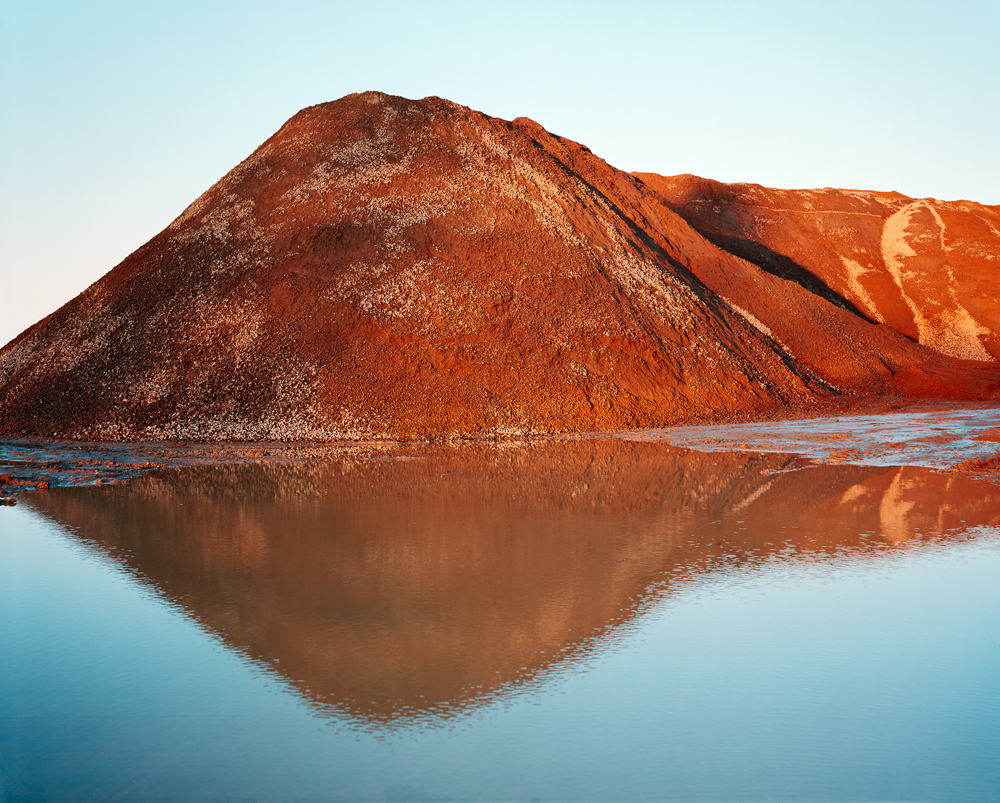 Mountain XI, 2012 © Peter Croteau
Mountain XI, 2012 © Peter Croteau
AL: The photographs are very fresh, in the sense that you have depicted something rather unexpected and often overlooked. What was it that fascinated you about common piles of earth, or did you seek them out in order to visually communicate an already-formulated concept?
PC: What fascinates me is the existential nature of man I see held within these spaces. I see man creating his own destiny in the ever-shifting American frontier of dross. I am trying to further the ideas set forth by Joe Deal, about reimagining the world as something other. By focusing in on sites where man has had the most direct involvement, but reframing them as something natural, I am creating my own vision of the world, which speaks to how we bend the planet to our own will.
 Mountain XVI, 2012 © Peter Croteau
Mountain XVI, 2012 © Peter Croteau
AL: Are you continuing to make landscape photographs?
PC: I am working on a couple of different projects right now. First off, I have been trying to further develop the dialogue I started with “Mountains,” by trying to make spaces of dross look like other elements of the natural landscape, such as valleys, rivers and glaciers.
I am also just photographing the in-between spaces around Providence, documenting the shifting landscapes and trying to replicate some views after a period of time has passed.
Also, I have been going through photographs I made during undergrad in Stroudsburg, PA, of the main street and how it leads into a continuous strip that I feel comprises much of the American landscape.
Lastly, I have been skateboarding for over 15 years, and I am working on a project photographing the marks skateboarders leave behind on walls and other surfaces. I feel these marks relate to those of the Abstract Expressionist painters. I am attempting to make the case that these marks from skateboarding are analogous to the marks made by the modern artist.
Peter Croteau is an American artist and graduate of RISD. He was selected as one of the exhibiting artists for Klompching Gallery’s 2013 edition of FRESH: The Wall/The Page/The Internet, July 17–August 10, 2013.
Tags: Fresh 2013, Klompching Gallery, Landscape, Mountains, Peter Croteau, Photography
Posted in Photography | No Comments »
Frank Yamrus
Monday, April 2nd, 2012
interview by Darren Ching and Debra Klomp Ching
Untitled (Single Man) © Frank Yamrus
At Length: You’ve been a producing artist for some 20 years, but it’s been 6 years since your last solo exhibition in New York. Why has it been so long?
Frank Yamrus: Yes, you are absolutely correct. My last one-person exhibition in New York, Bared & Bended, was a collection of 42 images—landscapes documenting my first and only winter in Provincetown on Cape Cod. These images were made in 2004 and at that time I was struggling with a personal relationship and starting to feel burnt out by my photography career. It seemed quite natural for me to seek refuge, in this place that I call my spiritual home, for contemplation.
Over the course of my winter on the Cape, I found great solace in this landscape, seemingly familiar but now blanketed by winter’s elements and surrounded by thick wintry light. After making this work, I put my camera down to reevaluate my career in photography. It was not until a couple years later that I felt the creative juices flowing, and again, it was a personal crisis—of sorts—and while in Provincetown, that inspired me to reach for my camera.
This six-year lapse reflects the time it took me to make this work and, to be quite honest, to feel comfortable with releasing this highly personal body of work to the public. Early in the process I showed some images to get feedback, but then went back to work very privately and quietly. I rarely shared any of these new images made after 2008. Last year, when Brian (Clamp) and I sat down to look at the work, he was surprised at the depth of the portfolio.
Untitled (Smoke) © Frank Yamrus
AL: It’s no secret that your newest body of work, I Feel Lucky, really results from—or at least was sparked by—a mid-life crisis. What role have the photographs performed, in the journey that you’ve made as you approached and passed the age of 50?
FY: As a photographer I don’t think I knew of another way to process this landmark event, so it was quite natural for me to reach for my camera and make these photographs. That very first impulse to take a picture felt unsurprisingly familiar and yet awkward, as I was not convinced I was ready to make work. However, once I made the first image, I was seduced, and the project began to slowly, but consistently, reveal itself. As I documented this journey, it gave me the opportunity to take another look at my life’s decisions and retrace my path to 50 as well as look beyond.
Initially, I made photographs about the “big” decisions, and some of those images feel appropriately iconic. As the project expanded, the “smaller” moments gave life to the narrative and helped me to see a more congruous life. Most of all, this process was empowering, as the images became cornerstones of my understanding, each image leading to another, creating dialogue to address the complexities of identity and life. Ultimately, I felt confidence and inspiration from these pictures and the response to this work has reinforced those emotions.
AL: Throughout the series, we witness the whole gamut of dispositions and emotions that you’ve experienced—humor, introspection, loss, joy, frustration, uncertainty, self-gratification, confidence—and yet, together, I Feel Lucky appears to be just a small glimpse of Frank Yamrus.
FR: Life is full and very complex. I agree this is but a glimpse of Frank Yamrus. Diane Arbus once said, “[a] photograph is a secret about a secret. The more it tells you, the less you know.” I subscribe to this sentiment and my imagery is, and has always been, about process and not about resolution.
The I Feel Lucky images, individually and collectively, inform. They are the evidence of life’s full spectrum of offerings: my hopes and dreams, my joy and sorrows, my happiness and pain, etc. And in spite of the filters of time and memory, the human desire to fabricate and stretch reality, these images feel authentic, and provide clarity and insight. Surely they capture the essence of my identity but, by no means, reveal all my secrets or truths.
Untitled (Boo Boo) © Frank Yamrus
AL: Does this survey of feelings, then, suggest a lack of answers, a lack of catharsis in facing up to and surviving a questioning of identity? Or would you say they represent an acceptance or acknowledgment of who and where you are?
FR: This survey of feelings is the very foundation of self-identity, and does not represent a lack of answers at all. As my personal history played out before the camera, these were the very elements that were the most closely scrutinized. I found this process to be emotionally rigorous and intellectually challenging, but in the end, oddly comforting and extremely rewarding. One of the many beautiful things about age is wisdom, and this investigation certainly uncovered the wisdom I acquired over my life’s journey. I was not looking for “answers,” although that in itself may be “the” answer. Fundamentally, I was interested in the evolution of identity. For example, two of the images I made for this series, Untitled (Lucky) and Untitled (Fountain), explore my relationship with my history and, ultimately, my identity in Provincetown.
In Untitled (Lucky) I’m disguised behind my shirt—not wanting to be recognized and not wanting to tempt fate—in this land that I once called sacred, that was my altar as I processed the loss of many friends. Sometimes I do not recognize myself in this reverent landscape under any other circumstances. Other times, when the stars are properly aligned, I embrace the entirety of that history confidently. My face is unmasked in Untitled (Fountain), as I mischievously glance at the camera and brashly spit a fountain of salt water. Fully exposed to the summery sunshine and brilliant blue water, I playfully seize the spirit of Provincetown and stake out my future in this land that holds my past.
AL: Provincetown is clearly of pivotal importance in your life. Why?
FR: When I made those landscape photographs on the Cape in 2004 that I referred to earlier, I wrote an essay about Provincetown that feels true to this day. “Provincetown is my home—it is comfort food and my favorite reading chair. It is the smell of a newborn’s hair or that moment when you first wake up in the morning snuggled against your lover. It is the place that offers me the intangibles: security and happiness, as well as the place for discovery, development, and ultimately a source of inspiration. I have spent endless summers in Provincetown but it is not where I reside. It is home, the place I visit, physically or emotionally, when I need a fix.”
Untitled (Sunset) © Frank Yamrus
AL: You published the series as a book. Do you see this as the ideal way for an audience to engage with the photographs?
FR: There a few things that I love about the book format for this project. First and foremost, the privacy and intimacy the book offers for these portraits is undeniable.
AL: One aspect of the book which works really well is that the photographs don’t appear to be arranged chronologically. It’s difficult to tell which image was made first and which last!
FR: Generally speaking, books tend to lend themselves to a linear read, which was not appropriate for this collection of photographs. With the I Feel Lucky book, I purposely avoided employing a chronological sequence. I was interested in creating an experience that reflected my non-linear process of examining, or perhaps more accurately, re-examining, these pivotal decisions and moments in my life. The dialogue created by the placement of the images was rooted in visual elements rather than related issues, feelings or chronology. This telling of my story had no beginning, middle or end.
AL: And as photographs, they’re printed at what, these days, is considered small-scale—measuring 20 x 28 inches. What determined the scale?
FR: As we all know, size matters, and for this work, this issue of scale was a delicate balance. My gut reaction was to make small prints to keep with the notion of private moments. I’m a fan of small images, and love the physical act of walking up to an image in order to digest it. However, I usually experiment with image size, and as I scaled-up the images from 5 x 7 to 10 x 14 and then finally to 20 x 28, these images came alive: facial details, gestures and background information commanded attention.
Another consideration, of course, was how the photographs would work in a gallery. My goal was to create a group conversation with the images, and as visitors walk into ClampArt they can hear the internal dialogue. At least I can. Image size and the density of the installation contributed to this success. When I took the 20 x 28 prints to the gallery, I felt this size met this goal and was happy that I was not printing on a larger scale, which oftentimes demands more visual space between the images.
Untitled (Disappear) © Frank Yamrus
AL: It’s interesting, too, that in a number of the photographs you’re not alone. Different people come into the frame and you provide little indication of their place in your world.
FR: The importance of my relationships was integral in my understanding of self. Although I don’t identify the people in my pictures, they are truly part of my life—sometimes playing themselves and at times playing others.
Untitled (Disappear) was constructed around the notion of anticipatory loss. As Sunil Gupta writes in his essay Everyman: Frank Yamrus, “Untitled (Disappear) is chilling. It evokes an insoluble mystery, a doubt that will linger forever. The nocturnal blue and the closed eyes remind us of impending gloom. This is a moment of recognition that a shared intimacy is no more. The image is more a requiem of a relationship than an image of the relationship itself.”
I don’t believe you need to know that the model in bed with me is Larry—my long-term partner of more than thirty years—to understand the significance of this photograph. In Untitled (Red), Lucas, a new love, serves as my model, but the image is more about a disconnect—anonymous sex and fetishism—than about our relationship.
In Untitled (Brooke) and Untitled (Stone), my models allowed me to explore the notion of fatherhood and visualize myself in a role that feels so completely foreign to me. The comfort I needed to make these pictures feel real was dependent on my close relationships with these models.
Lastly, in his essay The Borrowed Mirror, Bill Hunt addresses an image of me and my dad and insightfully captures my use of others in these photographs. He says: “Untitled (Dad) combines the dimensions of reality and fantasy effectively. The figure in the snapshot is less important than our sense that Yamrus’ search for meaning is entirely framed in this mirror. It is an image of reflection, handsomely and thoughtfully composed.”
Untitled (Dad) © Frank Yamrus
AL: Those who have followed your career for some time will recognize in this body of work, references to earlier photographs. Was this something that you consciously sought out?
FR: Yes, one of the underlying relationships that exist throughout this series is my relationship to photography, and my own work became fodder for this series. Being a photographer is a crucial part of my identity, and quite naturally referencing my own images became part of this process.
For example, I spent eight years in the moors of Provincetown making work about the loss of many friends to HIV/AIDS. I played off those images, that time, and my relationship to Provincetown throughout this series. Untitled (Sandman) and Untitled (Cemetery) are two examples. This tribute not only reflects my deep fondness for this place but also the importance of that time in my life and its impact on my career.
Untitled (Sandman) © Frank Yamrus
AL: Some will argue that self-portraiture is generally understood as the domain of the female artist. As a male, do you bring something different and new to this genre? If so, what is it that?
FR: I believe this argument has strength if we look at the genre in more contemporary terms; however, now we must consider the recent proliferation of self-portraits created for social media and how these pictures are shaping the complexion of this debate. Who hasn’t taken one or a hundred pictures of themselves to post on Facebook? However, my intention was to jump into this conversation with the same brutal honestly and raw vulnerability that I’ve noted in self-portraits made by women photographers. Even though my series is a blend of documentary and fiction, reality and fantasy, there is no denying its candor, humor and honesty. For me, that is what feels fresh about this work.
AL: From the point of view of commerce, do you feel there’s a place in public/private collections for these images? What transition, as an artist, have you made by placing highly personal images into the public domain—by way of the book and an exhibition?
FR: A number of these images have found their way into public and private collections, so my answer is a resounding “yes.” Although these images represent personal moments, I believe they also have a universal appeal as evidenced by these acquisitions. I generally don’t think about commerce while I am making work. But once it’s done, the work needs to find an audience. Sometimes this task is more challenging than making the work itself!
With respect to transition, I’m not quite sure enough time has transpired for me to answer this question. Initially, as I stated earlier, I was a bit skeptical about putting these images on public view, but thus far, I’ve received tremendous support. For the most part, I’m objective about the images as single pieces, however, collectively, as a body of work, I’m still attached. Interestingly, this attachment does not feel any differently than it did with other bodies of work I’ve created. Perhaps in years to come, I may feel differently about putting my face, my body, my being on public view but it’s much too early to tell. Although this work feels complete, I’m certain I will add pieces here and there. Who knows, I may go through this process as I approach 60. Right now, I’m ready to move on.
Untitled (Chapstick) © Frank Yamrus
AL: You seem to have survived 50! Do you really feel lucky and what are you moving on to?
FR: I do feel lucky, grateful and at the moment tired. The exhibition preparation and book were very consuming over these past 18 months. Next, I Feel Lucky moves to the Albert Merola Gallery for an exhibition, which will feature the images made in Provincetown, to kick off their summer season on May 18th. After that, a well-deserved vacation, perhaps some romantic walks on the beach taking corny pictures of sunsets and if my luck holds out Penelope Umbrico will find these pics on Google and incorporate them into one of her typologies! As far as new work, I’m interested in exploring my new hometown, New York, and its people.
Frank Yamrus lives and works in New York. In February 2012, I Feel Lucky was a solo exhibition at ClampArt in New York City coinciding with the publication of the accompanying book. I Feel Lucky will next be exhibited at the Albert Merola Gallery in Provincetown, May 18–June 7, 2012.
Tags: ClampArt, Frank Yamrus, I Feel Lucky, Klompching Gallery, Photography
Posted in Photography | No Comments »
